- Skip to main content
- Skip to primary sidebar

Wilderness Inquiry
Share the adventure!

We're happy to answer any questions you have!
- Name * First Last
- Comment or Question(s)? *
- Subscribe to News and Updates
- Are you a robot?
- Comments This field is for validation purposes and should be left unchanged.

Boundary Waters Canoe Area
Paddle million-acre wilderness.
The Boundary Waters Canoe Area Wilderness is America’s premier canoe destination. It is also one of the most accessible wilderness areas in the United States, and where Wilderness Inquiry began operating in the 1970s. Over one million acres in size, the Boundary Waters covers much of the Superior National Forest in northeastern Minnesota. Paddle among towering pines in the home of moose, lynx, wolves, and bald eagles.
Every Wilderness Inquiry trip ensures your adventure is the best it can be. Decades of experience in combination with top notch food and gear make Wilderness Inquiry BWCA trips an exceptional value. Our classic 5-day Boundary Waters Canoe Area Paddle Adventure is the quintessential guided canoe trip . Paddle lightweight Wenonah kevlar canoes and camp in beautiful lakeside campsites. The Boundary Waters lodge based adventure is based out of stunning Wintergreen Lodge on White Iron Lake. From here, you’ll enjoy excellent BWCA day trips off the Kawishiwi River or the Fernberg Trail, returning to delicious meals, a glass of wine, and a comfortable bed at night. The Boundary Waters Family Canoe and Hike trip is geared for families and based at a Forest Service campsite, allowing us to do day trips in smaller groups into the Wilderness. Our Boundary Waters Winter Adventure changes it up for winter fun at Camp Menogyn on West Bearskin Lake. You will love dogsledding, skiing, and seeing the Wilderness dressed in its winter clothes.
Whatever Boundary Waters trip you choose, we know you will enjoy this iconic wilderness area and come to understand why it is beloved by so many.
View by Itinerary
View by date.
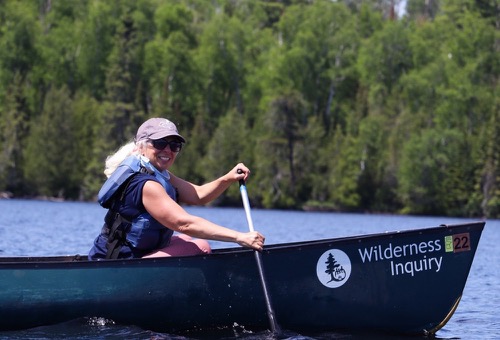
Boundary Waters Canoe Area Paddle Adventure
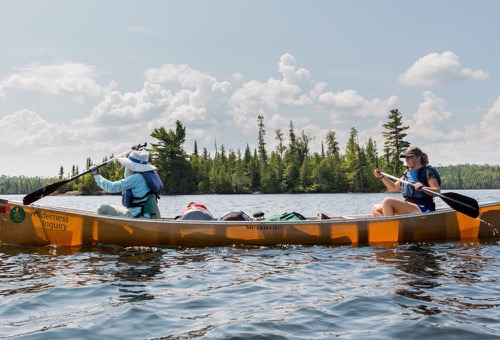
Boundary Waters Base Camp Adventure
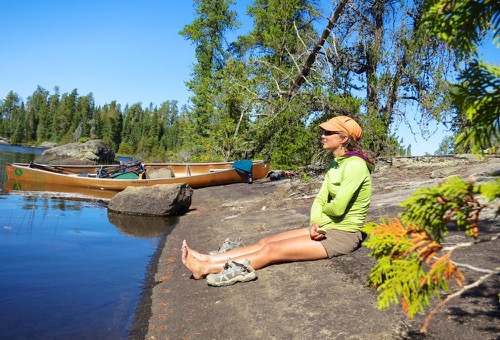
Boundary Waters Canoe Area Expedition
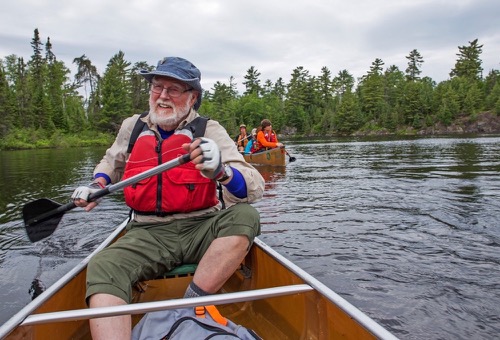
Boundary Waters Lodge-Based Adventure
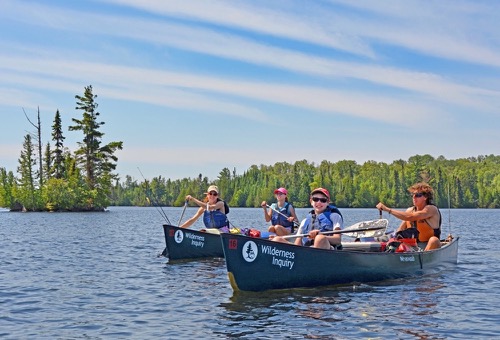
Boundary Waters Family Canoe and Hike
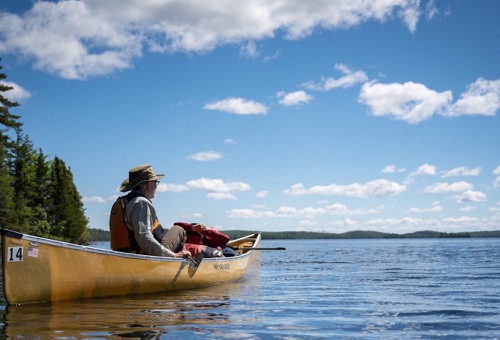
Boundary Waters Lodge-Based Reader’s Retreat with William Kent Krueger
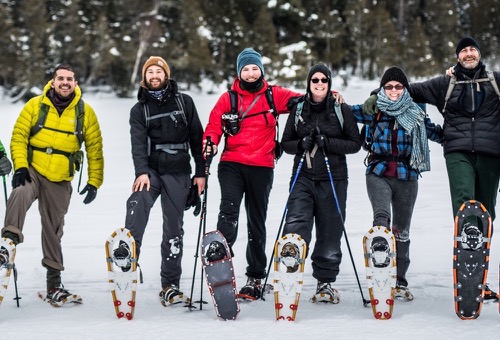
Boundary Waters Winter Adventure
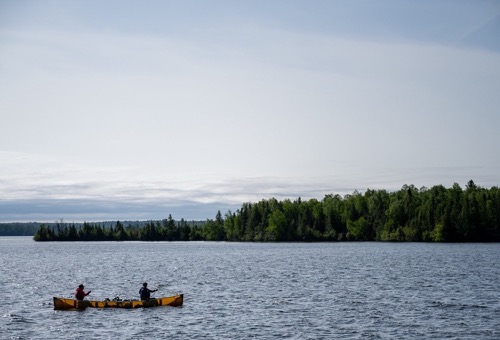
Boundary Waters Base Camp: Potlikker and Smoke with Chef Lachelle
About the area.
In 1964, Congress designated the BWCA as one of the first federally protected wilderness areas in the United States as part of the National Wilderness Preservation System. The BWCA, the northern third of Superior National Forest, lies on the international border between northern Minnesota and the Province of Ontario, Canada. Together, with the adjoining 1.2 million-acre Quetico Provincial Park on the Ontario side of the border, this international wilderness complex forms an unparalleled lakeland complex of 2.3 million acres, an area larger than Yellowstone.
Sculpted by glaciation, the area is part of the Canadian Shield, a geological formation that comprises portions of the earth’s most ancient exposed rock, some of which is 3 billion years old! The Boundary Waters contains about 1,175 lakes in all, creating a maze of interconnected wilderness waterways to explore. Whether you paddle one of the larger border lakes – Saganaga, Knife, Basswood, Crooked, Lac La Croix – or one of the smaller more intimate lakes, you’ll experience an undeveloped wilderness that appears much the same as it has for hundreds of years. Each lake brings its own distinct personality and you may find you and your canoeing partners each have a different favorite.
Two types of forests, the Boreal and Laurentian forests, converge to create a unique ecosystem with diverse plant and animal life in the Boundary Waters. Animals that would not normally be seen together, such as the white-tailed deer and the moose, have made the BWCA their homes. Many birds, such as bald eagles & loons, and over 20 species of wood warblers, use the Boundary Waters as their nesting grounds. Anglers can test their skills against the area’s lake trout, walleye, northern pike, or small and largemouth bass.
Humans have left their mark on the Boundary Waters as well. Native peoples inhabited the Boundary Waters area for thousands of years, with some human relics dating back to 10,000 BC. The Anishinabe (sometimes called Ojibwe, or Chippewa) and Dakota (Sioux) used the intricate waterways of the BWCA for hundreds of years. Native peoples first used many of the campsites and portages (paths between lakes) still used today. Artifacts from that period can still be found on occasion. European fur traders and missionaries first came into the area in the early 1700s. A working relationship developed between the European fur traders and the Ojibwe, based on trade of European goods for native knowledge and furs. This partnership ended in the mid 19th century due to the declining interest in furs as fashion.
Fur trading and logging of the Boundary Waters began taking its toll on the fragile ecosystem. People decided to act, setting aside this pristine area and working to protect it from further harm. In 1909, President Teddy Roosevelt established the Superior National Forest, with 1,000 square miles of roadless land (the precursor to the BWCA) later set aside in 1926 as the nation’s second administratively-established wilderness. The 1964 Wilderness Act designated the Boundary Waters as an original unit of the National Wilderness Preservation System, but with some compromises that allowed logging and motorboats to continue there. Congress passed additional protections for the BWCA in 1978, and expanded the area to its current borders and size of 1.1 million acres. The controversy surrounding this Congressional effort for the Boundary Waters also led to the establishment of Wilderness Inquiry; WI began by taking canoe trips in the BWCA and continues doing so to this day.
The Boundary Waters is one of National Geographic Traveler magazine’s “50 Places of a Lifetime.” Situated within Superior National Forest in northeastern Minnesota, the Boundary Waters Canoe Area Wilderness is a vast preserve of lakes and woods that stretches for about 100 miles along the U.S. border with Canada. Spread within the Boundary Waters are over 1,500 miles of canoe routes over more than 1,000 lakes, rivers and streams linked by trails called “portages.”
Due to strict permitting and non-motorized status the wilderness is yours to explore without people or vehicles. These factors contribute to the serenity of the area creating the perfect location for canoeing.
Camping for families
The wilderness is and ideal setting for families. Without the noise of daily life expect to learn more about yourselves and each other. The Boundary Waters Family Canoe and Hike trip is geared for families and based at a Forest Service campsite, allowing us to do day trips in smaller groups into the Wilderness.
Adventurers
Our classic 5-day Boundary Waters Canoe Area Paddle Adventure is the quintessential guided canoe trip for adventurers of all ability levels. Our experienced guides will teach you basic paddle strokes, the art of portaging a canoe, and can help you find a new appreciation for the great Northwoods.

How to Plan a Boundary Waters Canoe Trip in Minnesota
Start planning your Minnesota Boundary Waters canoe trip with this complete guide including BWCA entry points, Boundary Water camping, & more

Planning a Boundary Waters canoe trip in the Boundary Waters Canoe Area Wilderness (BWCA) involves navigating a labyrinth of over 1,000 lakes and islands. Located on the Minnesota/Canada border, I’ve made countless trips to the BWCA ever since I was a kid and it always delivers when I want a quiet week filled with great views and adventure.
The BWCA is the most-visited wilderness area in the U.S. and for good reason. From short overnight trips to multi-week remote adventures, the BWCA offers a unique camping experience for all skill levels. Like most remote camping trips, though, canoeing the BWCA requires planning in order to secure permits, learn how to navigate lakes and make portages, and assemble the right gear for a successful trip. I’ve made many trips to the BWCA, so in this post, I’m sharing all the important tips and guidance you’ll need to have a successful trip in Minnesota’s great north woods.
In this Boundary Waters canoe trip guide, I share everything you need to know to plan your own canoeing adventure to this amazing and remote area.
Important Reminder: As outdoor recreationists, it’s our responsibility to know how to recreate responsibly on the water whether we’re kayaking, paddleboarding, canoeing, rafting, or boating. Learn how to prevent the spread of aquatic invasive species with 3 easy steps that have a huge impact on our ecosystems.
Best Time to Canoe the Boundary Waters
Since the lakes freeze over in the winter, the best time to canoe the Boundary Waters is between spring, summer, and fall. Typically May through October is the canoeing season.
The summer months are the popular time to go, especially the back half of August. The water is warm enough to swim in and the weather gets up into the 70s and 80s. The main downside to canoeing in the summer months, however, is that mosquitoes and biting flies can put a huge damper on your trip. Bugs peak in mid-June and while the black flies last a week or two, the mosquitos stick around all summer. People share horror stories about the mosquitos, but truthfully they’re not much different than anywhere else in the Midwest.
Visiting during the spring is constrained to the month of May since the lake ice usually doesn’t melt until then. It’s a great month for fishing, solitude, and returning animals and birds, but it can be cold — lows are typically in the 40s.
Fall is one of the best times to visit the BWCA. There are fewer or no bugs, the crowds are basically gone, the fish are returning to the shallow water, and the fall colors are changing. Camping from mid-September to mid-October is the best time to visit if you want to catch the fall foliage as the aspen, birch, and maples leaves begin turning red, orange, and yellow. Make sure to check out these fall camping tips if you plan to visit during this season.
No matter what time of year you visit, it’s important to be prepared for cold temperatures, rainy weather, or submerged and wet gear. Always pack extra warm layers and don’t use cotton.

Planning Your BWCA Route
Bwca entry points.
There are two main BWCA entry points to start your trip: Ely and the Gunflint Trail . In general, the Ely area is quite wooded and has old-growth tree stands you can camp near. Visitors starting in the Gunflint area are likely to see the effects of fires and blowdowns, but while some forests in this area seem more sparse, there’s a more remote, rugged quality to this terrain.
I’ve done a handful of canoe trips out of Ely, but I prefer the Gunflint area for starting a trip because you immediately enter into wilderness with a rugged character.
BWCA Portages
If you’ve never been to the Boundary Waters before, it’s possible you’ve never had to portage a canoe before. Simply put, a portage is when you pick your canoe up and move it overland from one lake to another. The BWCA has over 1,000 lakes connected by portage paths of varying lengths — the shorter and fewer of them on your route, the easier it will be.
Portages are typically measured in rods, which is 16.5 feet long, roughly the length of your canoe. Portaging a canoe isn’t as hard as it seems and it’s actually easy to pick up and carry a canoe by yourself. It has more to do with skill than strength — forget the methods that have you quickly lift the canoe overhead like a powerlifter. Simply follow this method for picking up and carrying the canoe . I’ve seen retired folks do this in the BWCA with no problem at all.
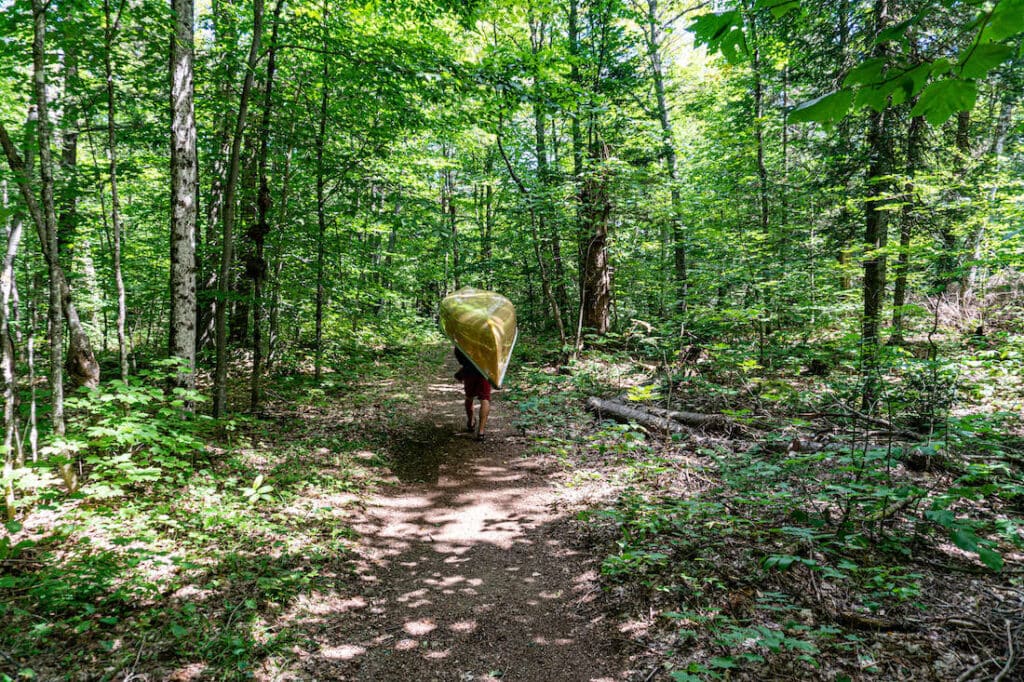
Boundary Waters Route Options
My favorite BWCA route is starting off at the Gunflint Trail at Saganaga Lake and canoeing to Red Rock Lake, Alpine Lake, and Sea Gull Lake to loop back to the start.
There are lots of different route options, though, and you can’t go wrong using the Trip Planner from the Friends of the Boundary Waters Wilderness (more on them later) to cater the route to your trip. You can choose different routes depending on your timeframe, how many portages you’d like to take, how long you want to paddle each day, and your current skill level.
Boundary Waters canoe rentals & Outfitters
While some people bring their own canoes to the BWCA, there are plenty of Boundary Waters canoe rental outfitters in both Ely and the Gunflint Trail. Not only are they inexpensive, but the guides here are a wealth of knowledge for planning your trip, asking questions, and getting some great beta on the best swimming spots and fishing holes. I’ve had great experiences with Voyageur Canoe Outfitters .
Keep in mind that the BWCA is a very large wilderness area, and with so many lakes and islands, you could spend a lifetime exploring different routes. No matter if you choose Ely or Gunflint as your Boundary Waters entry point, you’re going to have a blast.
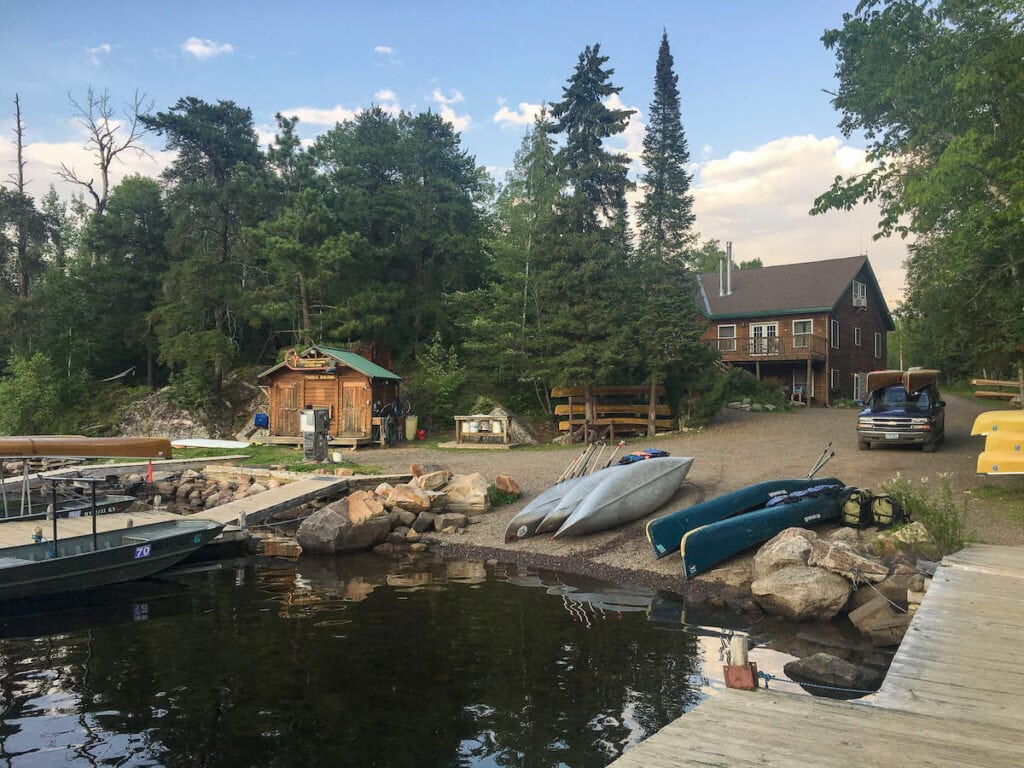
BWCA Permits
Once you’ve decided on where you want to start your trip, you’ll have to secure a BWCA permit. Permits are required for overnight trips from May 1 to September 30 . Walk-up permits are available the day of and the day before your trip, but their availability is not guaranteed. Keep in mind you don’t need to know exactly how many days or how many people are in your party to reserve a permit.
One Boundary Waters permit allows a group of up to 9 people and 4 watercraft to enter the wilderness . You can’t exceed the group limit at any time on water or land. Fees are $16 per adult per trip ($8 per kid per trip), and there’s also a non-refundable $6 reservation fee.
If you plan on fishing, obtain your fishing license before your trip either online or at any gas station/bait shop across the state. If you’re a Minnesota resident, an annual fishing license is $25 or $14 for 72 hours. If you’re a non-resident, it’s $51 annually, $43 for 7 days, or $36 for 72 hours.
The reservation system for Boundary Waters permits opens up at 9 a.m. CT on the last Wednesday of January every year on the BWCA recreation.gov website . If you plan on canoeing outside of the May-September season, you do not need a permit. BWCA canoe rental businesses can also provide permits.
You’ll need to pick up your permits in person at either a Superior National Forest district office or a BWCA outfitter in order to complete the mandatory Leave No Trace & Tread Lightly education session. This is a relatively short video/Q&A session that ensures visitors understand how to minimize their impact in the backcountry and stay safe in the remote wilderness.
While you don’t need a permit to bring a dog into the BWCA, you should bring a current rabies certificate and rabies tag on their collar. Dogs are welcome in the wilderness if they have good voice control, don’t bark or chase wild animals, have experience in a canoe, and are not left unattended . Always be prepared to clean up after your dog.

Boundary Waters Campsites
Boundary Waters campsites are spread throughout the wilderness area and tend to be on wooded shorelines. It’s pretty obvious where most of them are, and they are clearly labeled on BWCA maps. An easy way to tell if a campsite is occupied or not is to look for canoes on the campground shoreline. You can only camp at existing campgrounds in the BWCA and the campgrounds are first-come, first-serve .
It’s a good idea to break camp early and snag the campsite you’d like by early afternoon so you get the one you want. I once slept in and paddled during the afternoon instead and found every campsite was already taken at the lake I had planned to stay on. That meant a much longer day of paddling for me since I had no choice but to canoe on to the next lake and find the next empty campground.
My main consideration when choosing a campground is the view. Do you want to be on a peninsula surrounded by water, in a thickly wooded area, or do you want to make sure you have a great view of the sunset? Take your priorities into account when choosing your spot.
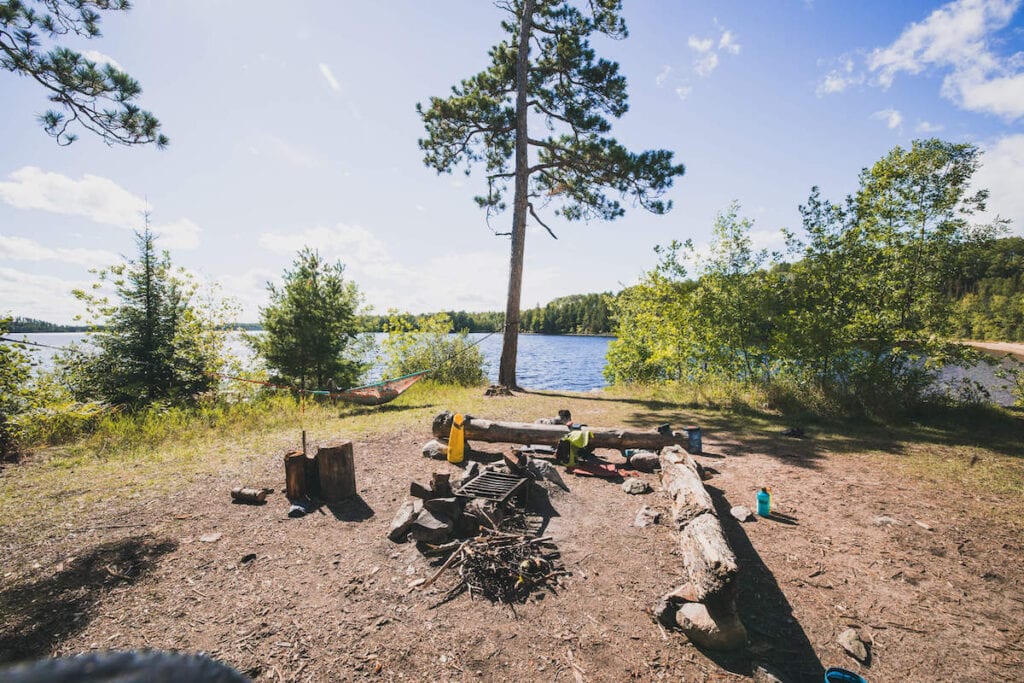
Boundary Waters Canoe Trip Gear
One of the best parts about canoe camping is that you only have to lug your gear on portages.
You can read our 3-day backpacking checklist to get a general idea of what you’ll need. It goes without saying that the Boundary Waters is a remote area; be sure to pack warm clothing and rain gear so you can stay safe in the event of storms, submerged and wet packs, or days or rainy weather.
Shoes for the BWCA
You’ll want good footwear for the Boundary Waters that can deal with water and rugged portages. I recommend water sandals whenever you’re in the canoe or getting in and out. Check our review of the Teva Universal Trail Sandal . These would be a great choice for a BWCA trip.
For portages, you’ll want hiking shoes or boots that have a closed-toe and closed-heel. These will keep your feet and ankles protected while carrying heavy packs and the canoe. Portages in the BWCA are filled with rocks, tree roots, and slippery mud so plan accordingly.
Dry Bags and Canoe Packs
While you can technically use a backpacking pack to carry your gear, using canoe packs from Duluth Pack, Frost River, or Granite Gear has its perks — it’s also what you’ll get from your outfitter if you rent a canoe. You can also invest in a few lightweight dry bags to keep your items dry and separated, like these Sea to Summit Lightweight Dry Sacks .
For a cheaper option, simply line your pack with a garbage bag and arrange your gear inside.
Navigating the Boundary Waters
You’ll need a compass, map, and map case (outfitters will provide these) for a Boundary Waters canoe trip. Fisher Maps , McKenzie , and Voyageur make the best BWCA maps or National Geographic also makes a detailed BWCA Map Pack . There’s little to no cell service in the BWCA, so don’t rely on your phone for navigation and pack or rent a satellite communication device for safety.
To navigate the Boundary Waters, your best bet is to orient yourself using portages, campgrounds, and prominent features of the shoreline like points, islands, bays, etc. It’s normal — and a right of passage — to get pretty confused about exactly where you are since the lakes and islands can make it seem like a maze. Don’t worry, it’s rare for visitors to actually get lost!
Water Gear & Equipment
Aluminum canoes are heavier to carry on portages, but they’ve got one big benefit: they’re bombproof. No need to worry about scraping a rock in these! Kevlar canoes are more fragile and require extra effort when using them, but they’re much lighter to use while paddling and portaging.
You’ll also need a fair amount of gear for your canoe (outfitters will provide all of this): paddles, life jackets , duct tape, sponge and bailer, and cords to tie in your packs. If you’re planning to fish, bring a pole and tackle box. And don’t forget a swimsuit!
Essential Clothing for Paddling
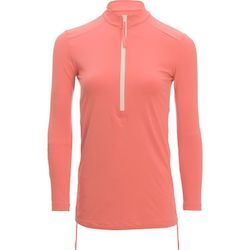
Carve Designs Cruz Rashguard
I prefer wearing a rashguard over sunscreen these days. I own the Cruz in 2 colors and it’s a staple for any water activity because it dries quickly but also keeps you cool, plus the cut is flattering.
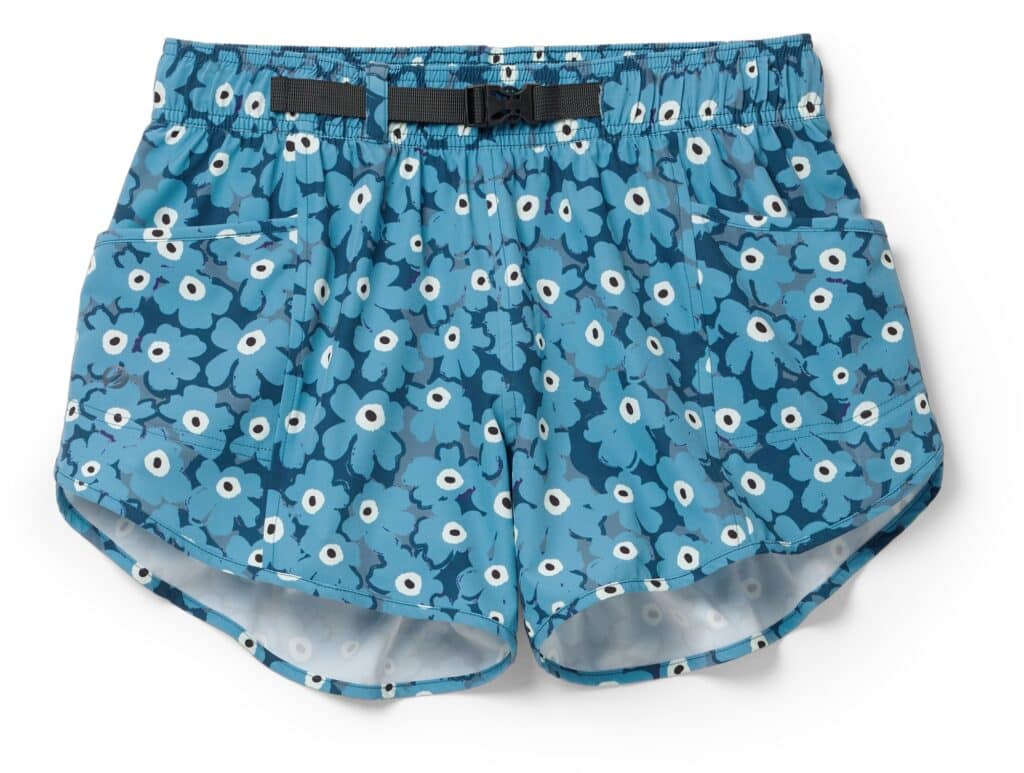
Nani Swimwear Hybrid Explorer Shorts
These shorts are super comfortable, dry really quickly, and come in a bunch of colors and prints. I wear them on all water adventures!

Teva Universal Trail Sandals
Sandals that stay on your feet and can get wet are essential. I like these because they have good grip and can be worn hiking as well, plus they can easily be strapped to your boat when not in use.

Outdoor Research Sunbriolet Hat
You’ll want a wide-brim hat that can get wet and has a chin strap so it stays on in the wind. This Outdoor Research hat is quick-drying, will float if it falls in the water, and comes in a variety of colors.
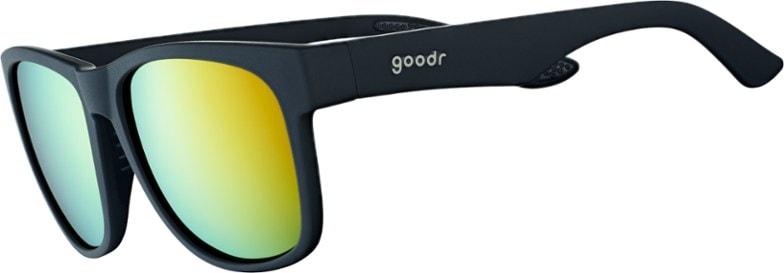
Goodr Polarized Sunglasses
Polarized glasses are best for the reflection of the water. I like to wear budget-friendly sunglasses paddling and I always wear a retainer so I don’t lose them in the water.
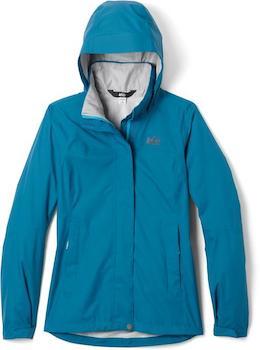
REI Co-op Rainier Rain Jacket
If it’s chilly or windy it can be helpful to have a lightweight rain jacket or windbreaker out on the water with you. I usually pack a jacket like this just in case!
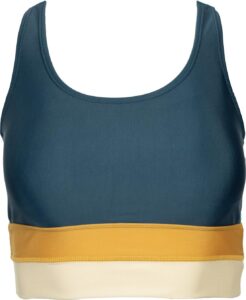
Supportive Swimsuit or Sports Bra
You’ll want a comfortable swimsuit that you can be active in. I like to avoid swimsuits that pull on my neck (like halters) and have been loving Nani Swimwear lately.
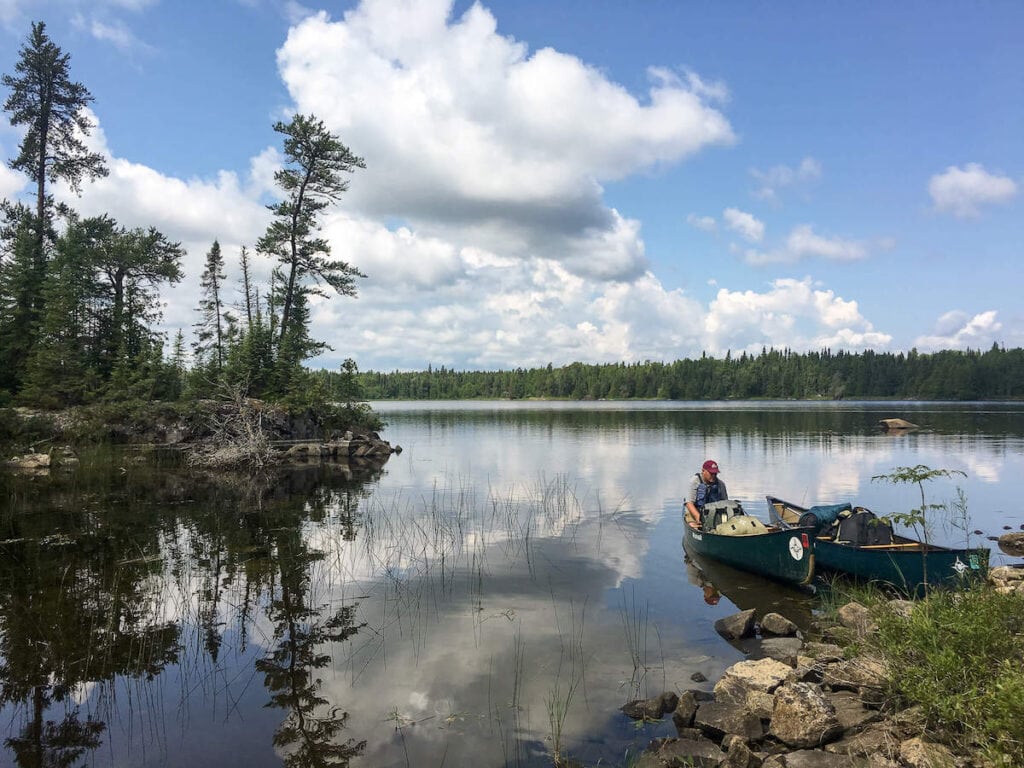
There are bears that live in the BWCA, but they rarely bother people. Most visitors opt to hang their food from a tree instead of bringing a bear canister. To hang your food bag, find a tree limb about 15-20 feet off the ground. Attach a heavy item to the end of your rope and throw it over the branch so that the rope is 4 feet away from the trunk. Now attach your bear sack to the rope, pulley your bag into the air, and tie off your rope. With a little searching, you can usually find a popular tree limb that’s used near each campground.
Water Filtration
Luckily, obtaining water in the Boundary Waters is much easier than most backpacking trips. While old-timers may still drink straight from the lake, it’s safer if you boil or filter the water. Simply paddle out away from your campsite and fill your containers from the lake, then purify or boil the water before using. While I used to drink straight from the lake, it’s not worth risking a Giardia infection.
The Platypus GravityWorks filter system is simple to use without needing to pump it. I’ve also used a Katadyn Hiker Microfilter in the BWCA, too, which I like because you can filter water straight into your water bottle while you’re canoeing.
I recommend filling and treating a 1- to 3-gallon water container when you arrive at your campsite to use for dinner, breakfast, and filling smaller 1-liter Nalgenes for the next day’s paddle.
Fire, Camp Stoves, and Cooking Gear
BWCA campgrounds have a fire pit area that can be used for cooking as long as there isn’t a fire ban in the area. The fires must be small and be put out completely when you’re not in camp. Firewood is available from the surrounding forest, but remember to only take dead and downed wood — live wood doesn’t burn well, anyway. If there is a fire ban, bring a camp stove for your cooking.
Sun Protection
It’s easy to get sunburned on a Boundary Waters canoe trip. Not only are you spending a lot of time out under the sun, but it’s also reflecting upward from your canoe and the water, too! Use sunscreen , a sun hat , and consider UPF clothing to keep the sun at bay.
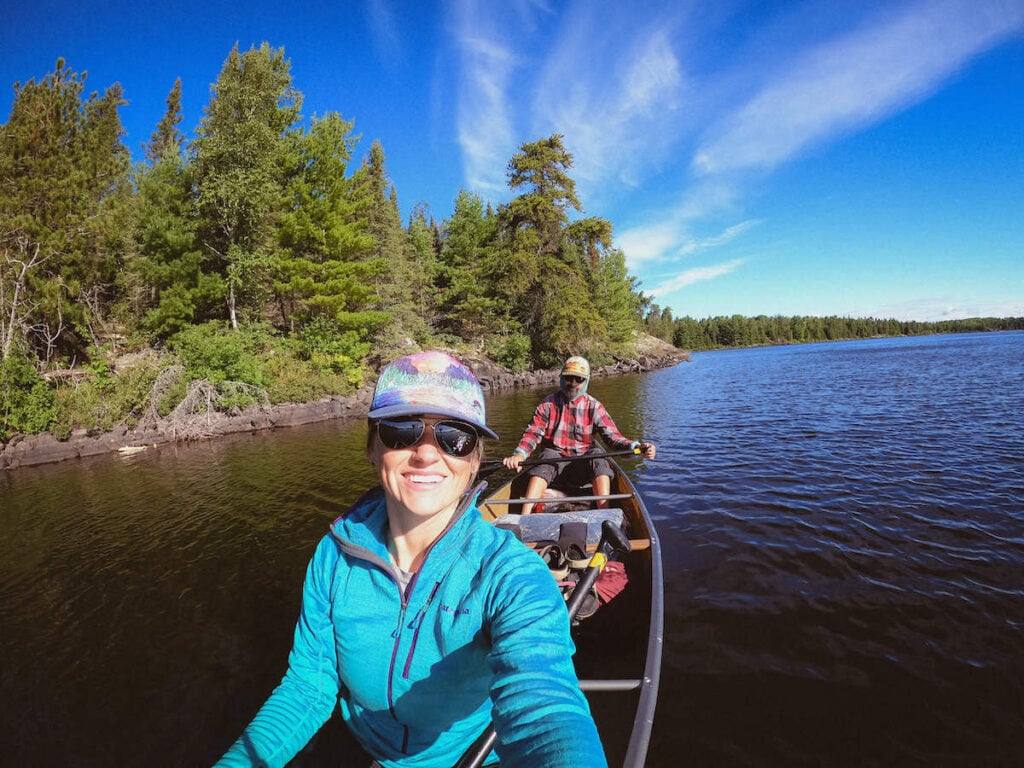
Help Protect the Boundary Waters
The BWCA is a unique, special place. But that doesn’t mean it always will be. Consider supporting the Friends of the Boundary Waters Wilderness to ensure this national treasure stays protected. Proposed copper-sulfide mines like Twin Metals risk contaminating and permanently polluting the Boundary Waters.
Learn more about threats to the BWCA and how you can help protect it by supporting Friends of the Boundary Waters Wilderness .
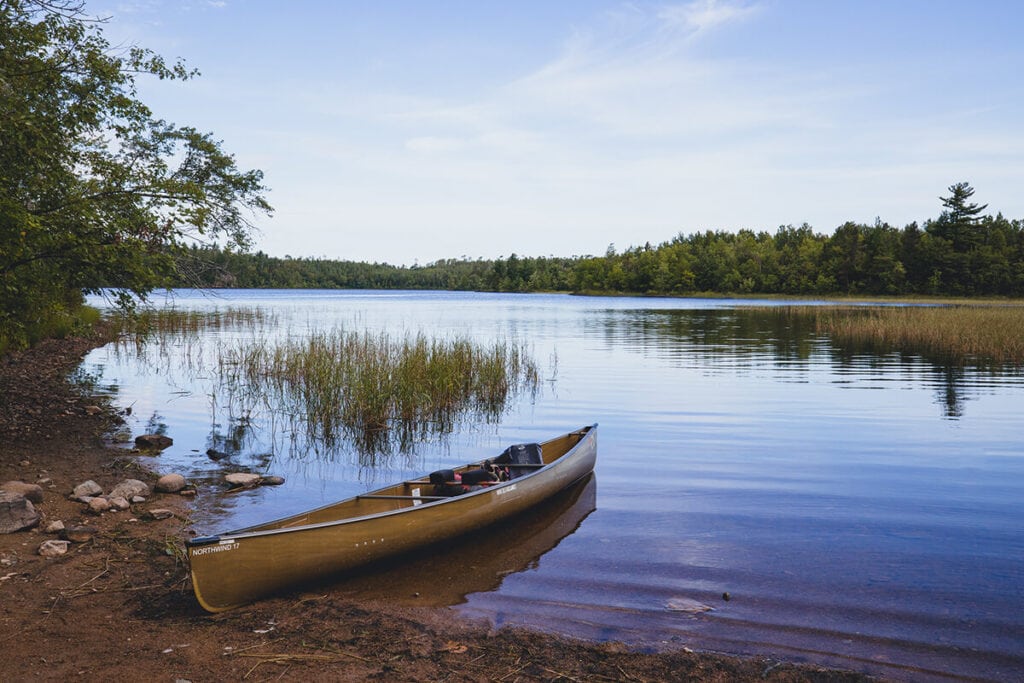
Taking a canoe trip through Minnesota’s Boundary Waters is a trip unlike any other, and thanks to its massive size and undeveloped character, it’s a wilderness you can return to again and again for new adventures. Whether you’re a seasoned paddler or new to canoe camping, the BWCA will not disappoint!
Have you done a Boundary Waters canoe trip or are you planning one? What questions do you still have? Let us know in the comments!
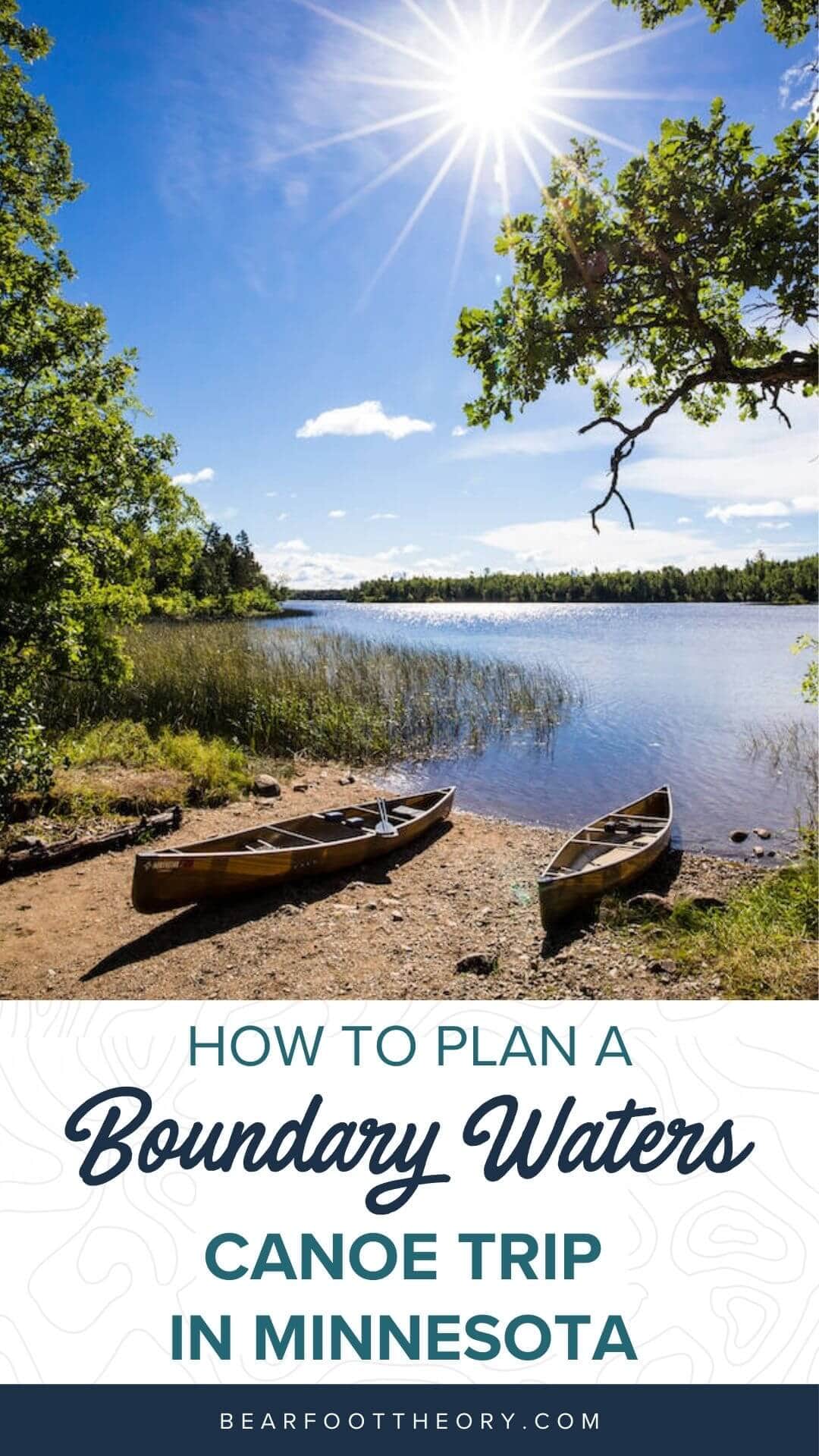
Isak is an outdoor freelance writer that loves traveling through Western public lands in his self-converted van to hike, ski, and find the country’s best used bookstores and coffee shops. When he’s not writing or adventuring, Isak is working on Seek More Wilderness to provide outdoor goods that give back to the outdoors. You can view his writing clips at IsakKvam.com and follow his van adventures on Instagram.
Leave a Reply Cancel reply
Your email address will not be published. Required fields are marked *
Save my name, email, and website in this browser for the next time I comment.
I just got back from the Boundary Waters (6 days, 5 nights in early-mid Sept) and it was amazing. I’m definitely making a trip back sometime, even though I had moments of questioning if i signed up for type 2 fun…. 1) drizzle to rain to soaked tent on night #2, 2) deluge welcomed us to a steep, rocky, slippery campsite, 3) trying to carry a canoe (even part way) on a mile long, level 8.5 portage (and then to find out that was only the second portage of a 3x portage day)…. but then we rewarded with the most beautiful rainbows, silence, starry nights, and disconnection from civilization. Great write up!
That sounds like an adventure!
Amazing clicks of pictures! we have done with same place and its look like a heaven on the earth and we enjoyed our trip. Before visiting this place, we consult with Boundary Waters Catalog about the place and we bought some tools from them. We got some information from some blogs and our trip was amazing.
Hi Eric, thanks for reading & the tip for the Boundary Waters Catalog. Glad you had an awesome trip!

- BEST AMERICAN ADVENTURES
Canoe the Boundary Waters, Minnesota
See trip details for canoeing the Boundary Waters in Minnesota, one of 100 best American adventure trips from National Geographic.
If you’re planning to rob a bank in the Midwest, arguably your best escape route is through the Boundary Waters Canoe Area. After entering this one-million-acre (400,000-hectare) bastion of lakes, streams, and primordial pine, birch, and aspen forests, you’re very unlikely to be found. That goes for law-abiding escapists, too. The Boundary Waters offer some 1,500 miles (2,414 kilometers) of canoe routes and 2,000 secluded campsites; in other words, it's the perfect territory in which to disappear for a while.
Plenty of people organize their own trips into the BWCA, but it’s far easier to let Ely, Minnesota-based Boundary Waters Outfitters do the work. They’ll organize meals, plan a route, rent equipment, and hand over all the maps. For true solitude, go in late August or early September when the summer crowds have thinned, or have the outfitters charter a float plane, which will drop you off far away from any signs of civilization.
Take at least four days to explore lake after lake, punctuated by rocky cliffs, waterfalls, and Native American pictographs. That’s about how long it takes to tune in to the heartbeat of this place—the silky water, the changeable skies, the deep fairy-tale-like forest, and all of the small details: moose and deer frequenting the shallows, eagles gliding between trees, and fresh wolf prints on shorelines.
Need to Know: Boundary Waters Outfitters ( www.boundarywatersoutfitters.com ) fully outfits trips and offers guides on a custom basis . Unguided, four-day trips start at $406 per person.
« Previous: Race the Arrowhead 135
Next: Hike the Superior Trail »
- Nat Geo Expeditions
FREE BONUS ISSUE
Related topics.
- TRAVEL AND ADVENTURE
You May Also Like

The 31 best Greek islands to visit in 2024

Canada's greatest natural wonders, from icebergs to the world's highest tides

Bear Grylls reveals his top travel tips

How to plan the ultimate campervanning adventure through Australia

How to explore Argentina's wild Misiones province through the eyes of the Indigenous Guarani people
- Environment
- Perpetual Planet
History & Culture
- History & Culture
- Mind, Body, Wonder
- Paid Content
- Terms of Use
- Privacy Policy
- Your US State Privacy Rights
- Children's Online Privacy Policy
- Interest-Based Ads
- About Nielsen Measurement
- Do Not Sell or Share My Personal Information
- Nat Geo Home
- Attend a Live Event
- Book a Trip
- Inspire Your Kids
- Shop Nat Geo
- Visit the D.C. Museum
- Learn About Our Impact
- Support Our Mission
- Advertise With Us
- Customer Service
- Renew Subscription
- Manage Your Subscription
- Work at Nat Geo
- Sign Up for Our Newsletters
- Contribute to Protect the Planet
Copyright © 1996-2015 National Geographic Society Copyright © 2015-2024 National Geographic Partners, LLC. All rights reserved
- Skip to content
- Skip to primary sidebar

Tanner's Trails
Long Term Adventure, Expeditions, Survival, Bushcraft And Self-Reliance
Boundary Waters Packing List: Ultimate Guide To Everything You Need
All Posts , Camping , Minnesota , Outdoors , Travel / Last Modified: September 6, 2023 by Tanner's Trails
Every year since 2020, I have embarked on a solo wilderness journey throughout the Boundary Waters Canoe Area Wilderness. During my research and trial process, I found exactly what gear is necessary on any multi-day canoe excursion up North, so with that said, here is my complete guide for a boundary waters packing list .
Before I begin, it is important to know how to stay safe while in the wild. So I want to share something.
Did you know that every year, people tragically pass away in the Boundary Waters wilderness due to drowning?
The reality is that more than 90% of these individuals weren’t wearing a life jacket . Wearing a life jacket while paddling isn’t just important – it can save your life! Don’t be another statistic – put on a PFD and paddle safely.
Now that that’s clear, lets begin the fun stuff!
Preview: In this article, you will be able to see EVERYTHING that I bring with me on my wilderness canoe trip. In the end, you will also be able to see some other useful canoeing information ranging from maps, safety tips, and more.
1. Canoe Gear
2. canoe packs, 3. sleep system, 5. clothing, 6. camp kitchen, 7. hydration, 8. electronics, 9. navigation, 10. first aid/toiletries, 11. fishing, 13. miscellaneous, 14: portaging, suggested reading:, suggested maps:, other resources:, complete boundary waters packing list.
This gear list has been dialed down after many trips including a 30-day solo traverse of the entire wilderness area . I’ll put my recommendations as well as the reasoning behind the gear I brought!

Canoe Gear Checklist:
- Canoe (Kevlar Material For Easier Portaging)
- Sponge (For Small Puddles In Canoe)
- Paddle (I Ain’t Swimming
- Backup Paddle (Paddles Break Easily, Foldable Paddles Work As Backup)
My solo canoeing experience was completely transformed after I discovered the Wenonah Encounter 17ft solo canoe as it seemed to be the perfect vessel for the large open-water route that I took. It proved to be immensely steady, lightweight, and reliable enough that I had no qualms about trusting it on a month-long excursion.
If I were ever to do this again, I’d use exactly the same canoe; an old preloved one purchased from Boundary Waters Outfitters .
Choosing The Right Canoe
When looking for a canoe, it is important to consider the various available models and materials. Kevlar canoes are especially popular (95% of paddlers in the BWCA) among boaters in the BWCA, while aluminum canoes are also an option worth considering. Here are the benefits/downsides of each:
Kevlar Benefits: Kevlar canoes are favored by many boaters due to their lightweight yet durable design. They offer superior speed and maneuverability, making them ideal for those who want to explore the Boundary Waters with a sense of agility. Additionally, these boats are highly resistant to abrasion and corrosion. This makes them particularly suitable for Boundary Waters conditions.
Kevlar Downsides: Kevlar boats are usually expensive and require more maintenance than their aluminum counterparts. They may also be prone to punctures, so it’s important to inspect them regularly, as well as check for any potential leaks and carry a repair kit.
Aluminum Benefits: Aluminum canoes are known for their rugged construction and excellent durability. They are often less expensive than Kevlar canoes, require minimal maintenance, and can stand up to a significant amount of rough wear and tear. Additionally, they offer impressive maneuverability in Boundary Waters conditions, making them great for those who want to explore more remote areas.
Aluminum Downsides: Although they are relatively lightweight, aluminum canoes tend to be heavier than Kevlar boats. They may also require more effort when it comes to turning and maneuvering in tight areas.
One staple that should always be attached to your canoe- or any boat really- is a sponge. There were times when it would be drizzling when I’d be out paddling and the sponge, which was attached with a bungee cord, allowed me to prevent water from pooling in the bottom of the canoe.
Canoe Paddle And Backup
Choosing your canoe paddle can be a personal preference, but it is important to have a paddle that suits the Boundary Waters. Bending Branch offers a variety of high-quality paddles designed specifically for canoeing in Boundary Waters conditions.
The brand provides single-blade, double-blade, and bent-shaft designs that are all lightweight yet sturdy enough to handle any challenge you may encounter on the water.
It is always wise to keep a spare paddle with you while canoeing. Crafting a secondary paddle may be an option (good luck), but having one prepared in advance will make your life much easier. I attached my backup oar to the hooks located on my vessel using zip ties for added security and convenience.
Canoe Paddling Safety Tips
As I embarked on my canoeing excursions, I typically kept a rope connected from the front handle of my vessel to the back. This was an easy and effective way for me to guarantee that even if I flipped over in choppy waters, all of my bags would remain tethered firmly to the boat. A minor precaution like this can be invaluable!
Also, to add to the above, and to ensure maximum safety while paddling, it’s essential to attach a FLOATING rope from the back handle that trails in the water. This is especially important when out on wide-open lakes with strong winds – because if your canoe overturns, you don’t want it drifting away! While this may seem like only a small detail, it can be crucial for keeping yourself safe and sound.

Canoe Pack Checklist:
Canoe barrel (2x).
- Canoe Barrel Backpack
- Small Backpack
After much consideration, I selected two 60-liter canoe barrels for my wilderness trip. They are incredibly rugged and buoyant, as well being waterproof and easily tucked away in the canoe itself. Had it been a short trip, one would have sufficed; however since this was a journey of several weeks’ duration, I opted to store all my necessary items in one barrel while keeping food reserves in the other.
All that said – if you prefer them – traditional backpack options will work just fine too!
Everything in my boundary waters packing list would fit directly into two of the canoe barrels if I was doing a trip 2 weeks or shorter. Since I had 4 weeks total of food, I had an extra small pack listed below.
Canoe Barrel Pack
I needed a canoe barrel pack to be able to portage effectively, so I had no choice but to double-portage each time given that my pack could only carry one barrel at once. Fortunately, the quality and craftsmanship of this particular piece were truly remarkable – it exceeded my expectations in every way! I couldn’t be more pleased with its performance.
Smaller Pack
I opted for the Petzl Transport 45 Liter Backpack because of its convenient size. It did exactly what I needed, but any comparable-sized bag would have been just as great! Additionally, shorter trips would allow for different packing methods.

Sleep System Checklist:
Sleeping pad, sleeping bag, waterproof compression sack.
Foam pad. You can’t beat the durability and I personally sleep better on them. I like them because foam pads are incredibly durable and can withstand the rigors of any terrain, and they give you added versatility when it comes to packing items for Boundary Waters excursions because you can use them as a seat around camp.
Marmot Trestles 20 Degree Sleeping Bag: Perfect bag for paddling. The fill is synthetic and will still insulate when wet, yet the bag is still lightweight and packs down well enough. Synthetic insulation sleeping bags are a popular choice for Boundary Waters canoe trips due to the fact that they retain their warmth even when damp or wet. This makes them ideal for Boundary Waters Canoe Trips where you may tip a canoe!
To keep my sleeping bag and extras dry in the event of a spill, I opted for a 30-Liter Sea To Summit Compression Sack. This waterproof sack was more than enough to guarantee that my sleeping bag and clothes wouldn’t be left sopping wet!

Shelter Checklist:
I brought my favorite tent, the Nemo Dagger 2-Person tent. This includes the tent body, rainfly, stakes, poles, and guylines as well as 100 feet of paracord for tying out my tent during storms.
After using this tent for several years, I still find that I love it as much as I did when I purchased it. It is lightweight, durable, spacious, and versatile.
A hammock and tarp (10×12)is another common setup on other boundary waters packing lists as well!

Clothing Checklist:
- Portage Shoes
- Boxers (2x)
- Pants and Belt
- Rain Jacket
- Life Jacket
- Fleece Jacket
- Swim Shorts
- Baseball Hat
- Mosquito Headnet
Teva Sandals: Proved to be super efficient and durable/stable enough for portaging. Wet exits are a must for kevlar canoes, so any water shoes are essential.
Darn Tough Socks(2): These are always my go-to socks as they are 100% wool and have a lifetime warranty. I used an unknown brand of wool socks. Dry socks are important after a long day of wet feet.
Exoficio Boxers (2): My go-to underwear. They are great.
Duluth Long Pants: I wanted quick-drying, lightweight, and durable pants, which is precisely what Duluth had. Duluth brand pants fit me better than other brands.
Arcteryx Belt: Bombproof belt, but any belt would do.
Arcteryx T-shirt: I wear this under my sun hoody and around camp in the evening. I love the comfort of a regular t-shirt.
Rab Sun Hoody: I’m not too fond of button-up long-sleeve shirts as I find them highly uncomfortable. Sun hoodies are comfortable, block UV rays, and can be a part of your layering system.
Alaskan Hardgear Rain Jacket: This is a bombproof rain jacket that is not a typical raincoat. Any high-quality rain jacket will do- I was testing this one for a future adventure!
Garmin Watch: I used my watch mainly to set alarms each day. However, many other uses (like GPS) could be extremely helpful.
Astral Paddling Life Jacket: I wore this at all times. Too many people die in ways that could have been prevented had they been wearing a life jacket. Wear it..always!
Fleece Jacket: I used a regular Arcteryx Fleece zip-up jacket that is perfect for mild insulation on chillier nights.
Buff: This is a piece of gear I bring with me no matter the occasion. It is a versatile piece of gear and a part of staying warm for me.
Swim Trunks: Just any old pair of swim trunks if you decide to go swimming in some of the lakes!
Rain Pants: I rarely use rain pants but they are a good item to have to either block rain, bugs, or wind.
Baseball Hat: I never wear sunglasses (Unless I absolutely need to) so a nice wide-brimmed hat is essential for me.
Mosquito Headnet: I used a cheap mosquito headset as bugs have never bothered me too much. However, if mosquitos are usually a huge nuisance to you, I would recommend investing in a high-quality bug-proof system.
Flip flops: as camp shoes
Sunglasses: with a hard case and Croakies. Sunglasses are a must for Boundary Waters canoeing trips as the sun’s reflection off the surface of the water can make it difficult to see clearly.

Camp Kitchen Checklist:
- Canister Stove
- BIC Lighter
- Fuel Canisters (2 medium)
I prefer to cook over the fire, so I brought my large stainless steel pot. In case of a fire ban (like what happened during the trip), I also had my smaller titanium one ready. That’s why it is important to bring canister fuel. Tools like tongs allow for easier fish cooking when you are choosing to catch your dinner in the wilderness.

Hydration Checklist:
- Water Filter and Backflush
- Smart Water Bottle
- Metal Nalgene Style Bottle
Sawyer Water Filter/ Smart Water Bottle And Back-flusher: In the future, I would switch to an LED purifier as the water is already so clear that filtering or boiling becomes a hassle. With an LED purifier you are good to go after waiting a few minutes. I’d filter large particles with a bandana and let the LED do the rest.
A single-wall metal water bottle is an essential piece of gear to bring on Boundary Waters canoe trips. It allows for cooking directly on the fire, eliminating the need for a traditional stove. This type of water bottle is made from lightweight yet durable stainless steel, and you can make a homemade, insulated sleeve that prevents burns and helps keep drinks hot or cold for longer.
Ditch your plastic water bottles! They suck for real wilderness use.

Electronics Checklist:
- Electronics Bag
- Solar Panel
Electronics Bag: Featuring all the essential items for a BWCA trip, including a GoPro kit, tripod to steady camera shots, personal locator beacon for safety precautions and charging cords for watches and phones, cameras, etc. . Plus don’t forget about your headlamp. I brought a solar panel to stay charged up.
Camera Bag: In order to document my journey, I chose to attach my Waterproof camera bag (waterproof dry bag) to my canoe. Within this bag, I carried my camera, a GoPro, extra SD cards, and one extra GoPro battery. While this was certainly not necessary, having my camera handy proved to be effective when I caught a quick video of a bear when I turned a corner.

Navigation Checklist:
- National Geographic Maps
- Garmin Inreach
National Geographic Maps: With National Geographic Maps, I finally have the perfect maps for my Boundary Waters packing list. It’s essential to bring along hard copies of these maps; even though digital versions are handy too, they won’t suffice in all scenarios. As a result, don’t forget your paper ones when you head out on an adventure!
Garmin Inreach: I never leave home without my Garmin Inreach, which in this case was always secured to my life jacket. This device lets me stay connected with loved ones and sends out an SOS signal in times of danger or distress – proving to be essential while exploring the unknown.
Compass: I never found it necessary to use the compass but I believe it is wise to have and be trained on using it.


First Aid/Toiletries Checklist:
- WFR Booklet
Medicines: When engaging in wilderness medicine, it’s wise to have a comprehensive selection of over-the-counter items on hand; think Benadryl, Nyquil, Dayquil Ibuprofen, and Neosporin. Also, it proved to be valuable to understand the medicinal plants of the area.
Toiletries: 45 SPF Sunscreen (2), Mini Toothpaste Tubes(2), Floss, Toothbrush, Tweezers, Nail Clippers, Bag with TP, Etc.
NOLS Wilderness First Responder (WFR) Book: This is the go-to guide for wilderness medical emergencies and first aid situations. It outlines essential principles, provides detailed information on medical assessments and treatments, and covers all aspects of wilderness medicine.
The comprehensive book also contains an array of helpful checklists, diagrams, and illustrations to help make the most of the Wilderness First Responder training.
It’s important to remember that Boundary Waters Canoe Area Wilderness trips can be unpredictable, and being prepared for any situation is essential.
You are ahead of the curve since you are researching my Boundary Waters Packing List. This will give you a basis to start on and will allow you to learn from my mistakes.

Fishing Checklist:
- Fishing Rod and Reel
- Small Tackle Box
- Fishing Mouth Opener
Spinning rods/reels are the most popular style of a fishing reel in the BWCA because of their versatility and ease of use. These rods allow you to cast a variety of baits and lures, in addition to natural bait, making them an ideal choice for Boundary Waters Canoe Area Wilderness fishing trips.
My fishing gear collection comprises of a lightweight tackle box with jigs, spoons, lures, leaders, and white curly-tail plastic worms. Additionally, I have a filleting knife for cleaning fish along with pliers for convenience. Moreover, I made sure to include the wire stringer so that all my catches are safely kept in one place.
Quick Tip: Don’t String fish through their gills, instead poke the stringer through the bottom of their mouth. The fish will be alive and fresh longer.

When it comes to camping in the Boundary Waters Canoe Area Wilderness, it is essential to bring the right type of food. Olive oil, canola oil (for fish), honey, and powdered greens are all excellent options for adding healthy fats and nutrients to your meals.
For a protein boost, bring along some protein bars or powdered peanut butter and supplement it with freshly caught fish.
Searching for a sweet snack solution? Dehydrated mangoes, apples, bananas, blueberries, and pineapple are all great options.
If you’re looking to keep things simple in meal prep or want something easy to make on the go – Readywise and Mountain House dehydrated meals are my go-to options.
For those seeking more of a fishing adventure, Andy’s fish breading is an excellent choice for coating freshly caught fish. Oatmeal, trail mix, instant coffee, and vitamin C packets are also on my essential Boundary Waters packing list food items.
- Canoe Anchor
- Carabiners (4)
- Permit And Fishing License
- Journal And Pen
- Fixed Blade Knife
- Gorilla Glue
- Gorilla Tape
- Knife Sharpener
- BIC Lighter Backup
- Ferrocerium Rod
All of these items have self-explanatory uses.
A canoe yoke is a device used to create an even weight distribution across the back of a canoe while carrying it. It allows the user to easily portage the canoe while keeping the load balanced and stable. The yoke can be adjusted to fit various-sized canoes, allowing for an even weight distribution regardless of the vessel size.
Mine was a Wenonah yoke made specifically for my canoe!
Anyways, the Boundary Waters wilderness is a place of incredible beauty and adventure, and the items you bring can make all the difference in having an amazing experience or not. I hope this Boundary Waters Canoe Area Wilderness packing list guide has been useful to help plan your next canoe trip.
Good luck and stay safe.
Boundary Waters Packing List Resources

Wild Berries & Fruits Field Guide of Minnesota, Wisconsin & Michigan by Teresa Marrone If you are passionate about wild berries, this book is the perfect companion for you. It’s small and easily fits in your pocket, yet it provides accurate descriptions and helpful organization of information. Additionally, its color-coded system makes it simple to identify unfamiliar fruits; plus you can see an extensive list of berry varieties included in the book.

Boundary Waters Canoe Area Map Set by National Geographic Get your hands on this two-part Boundary Waters Canoe Area map set! I found it absolutely amazing and a lot more simplistic than some of the other, overly detailed sets sold out there. These maps include portage routes that cover all of the area from East to West in one neat package.
SEEK : Seek is a remarkable app that I often use to recognize plants from all around the world. Its precision and accuracy never cease to amaze me, plus it works seamlessly without any cell service. This feature alone makes Seek such an indispensable tool for any wilderness travel.
Thanks for checking out my boundary waters packing list!
Here are a few more related articles:.
- 11 Essential Camping Knots You Should Know To Unlock The Wild
- Solo Camping For Beginners: Everything You Need To Know To Stay Safe
- Week One: 30 Days Alone In The BWCA Wilderness
Disclosure: Please note that some of the links above are affiliate links. At no additional cost to you, I earn a commission if you make a purchase. If you have any questions about the companies or my status as an affiliate, please don’t hesitate to e-mail me.

Hey there! My name is Tanner and I specialize in outdoor survival, bushcraft, expeditions and adventure travel.
Share this:
Reader interactions.
[…] appropriate camping gear on your Boundary Waters packing list, prepare for comfortable nights under the stars. Ensuring a comfortable night’s rest is […]
- Meet the Team
- Work with Us
- Czech Republic
- Netherlands
- Switzerland
- Scandinavia
- Philippines
- South Korea
- New Zealand
- South Africa
- Budget Travel
- Work & Travel
- The Broke Backpacker Manifesto
- Travel Resources
- How to Travel on $10/day
Home » Europe » Moscow
EPIC MOSCOW Itinerary! (2024)
Moscow is the heart of Mother Russia. Just the mention of this city conjures images of colorful bulbous pointed domes, crisp temperatures, and a uniquely original spirit!
Moscow has an incredibly turbulent history, a seemingly resilient culture, and a unique enchantment that pulls countless tourists to the city each year! Although the warmer months make exploring Moscow’s attractions more favorable, there’s just something about a fresh snowfall that only enhances the appearance of the city’s iconic sites!
If you’re a first-time visitor to Moscow, or simply wanting to see as much of the city as possible, this Moscow itinerary will help you do just that!

Unlock Our GREATEST Travel Secrets!
Sign up for our newsletter and get the best travel tips delivered right to your inbox.
Best Time To Visit Moscow
Where to stay in moscow, moscow itinerary, day 1 itinerary in moscow, day 2 itinerary in moscow, day 3 and beyond, staying safe in moscow, day trips from moscow, faq on moscow itinerary.
Here is a quick look at the seasons so you can decide when to visit Moscow!
The summer months (June-August) are a great time to travel to Moscow to take advantage of the enjoyable mild temperatures. This is considered peak travel season. Bear in mind that hotel prices rise along with the temperatures!

If you’re planning a trip to Moscow during fall (September-November) try to plan for early fall. This way the temperatures will still be pleasant and winter won’t be threatening.
Russian winters (December-February) are not for the faint of heart as Napoleon learned to his peril. Some days the sun will be out for less than an hour, and snow is guaranteed. Although winters are exceptionally cold, this is when you’ll get a true glimpse of the Moscow experience!
The best time to visit Moscow is during spring (March-May). The temperatures will begin to creep up and the sun begins to shine for significant portions of the day. Hotel rates will also have yet to skyrocket into peak ranges!

With a Moscow City Pass , you can experience the best of Moscow at the CHEAPEST prices. Discounts, attractions, tickets, and even public transport are all standards in any good city pass – be sure invest now and save them $$$ when you arrive!
Moscow is a large city with many accommodation options to choose from. Staying in a location that fits with your travel plans will only enhance your Moscow itinerary. Here is a brief introduction to a few great areas of the city we recommend checking out!
The best place to stay in Moscow to be close to all the action is Kitay-Gorod. This charming neighborhood will put you within walking distance to Moscow’s famous Red Square, thus cutting down on travel time. This will allow you to see more of the city in a shorter amount of time!

It’s surrounded by restaurants, cafes, bars, and shops. If you’re a first-time visitor to Moscow, or just planning a quick weekend in Moscow, then this area is perfect for you!
Another great area to consider is the Zamoskvorechye district. This area of the city offers a blend of new and old Moscow. It has an artsy vibe and there are plenty of fun sites you can explore outside of the main touristy areas of Moscow.
Of course, as in all areas of Moscow, it’s close to public transportation that will quickly connect you with the rest of the city and make your Moscow itinerary super accessible!
Best Airbnb in Moscow – Exclusive Apartment in Old Moscow

Modern and cozy, this apartment is in the heart of Old Moscow. Bordering the Basmanny and Kitay-Gorod districts, this two-bedroom flat is walking distance to the Kremlin and Red Square. Safe, quiet, and comfortable, this is the best Airbnb in Moscow, no question!
Best Budget Hotel in Moscow – Izmailovo Alfa Hotel

The Izmailovo Alfa Hotel is a very highly rated accommodation that provides all the components necessary for a comfortable trip to Moscow. There is an on-site restaurant, bar, fitness center, and an airport shuttle service. The rooms are modern and spacious and are equipped with a TV, heating/air conditioning, minibar, and more!
Best Luxury Hotel in Moscow – Crowne Plaza Moscow World Trade Centre

If you’re touring Moscow in luxury, the Crowne Plaza Moscow World Trade Centre is the hotel for you! Elegantly furnished rooms are equipped with a minibar, flat-screen TV, in-room safes, as well as tea and coffee making facilities! Bathrooms come with bathrobes, slippers, and free toiletries. There is also an onsite restaurant, bar, and fitness center.
Best Hostel in Moscow – Godzillas Hostel

Godzillas Hostel is located in the center of Moscow, just a short walk from all the major tourist attractions and the metro station. Guests will enjoy all the usual hostel perks such as self-catering facilities, 24-hour reception, Free Wi-Fi, and security lockers. This is one of the best hostels in Moscow and its wonderful social atmosphere and will make your vacation in Moscow extra special!
An important aspect of planning any trip is figuring out the transportation situation. You’re probably wondering how you’re going to get to all of your Moscow points of interest right? Luckily, this sprawling city has an excellent network of public transportation that will make traveling a breeze!
The underground metro system is the quickest and most efficient way to travel around Moscow. Most visitors rely exclusively on this super-efficient transportation system, which allows you to get to pretty much anywhere in the city! It’s also a great option if you’re planning a Moscow itinerary during the colder months, as you’ll be sheltered from the snow and freezing temperatures!

If you prefer above-ground transportation, buses, trams, and trolleybuses, run throughout the city and provide a rather comfortable alternative to the metro.
Moscow’s metro, buses, trams, and trolleybuses are all accessible with a ‘Troika’ card. This card can be topped up with any sum of money at a metro cash desk. The ticket is simple, convenient, and even refundable upon return to a cashier!
No matter which method you choose, you’ll never find yourself without an easy means of getting from point A to point B!
Red Square | Moscow Kremlin | Lenin’s Mausoleum | St. Basil’s Cathedral | GUM Department Store
Spend the first day of your itinerary taking your own self guided Moscow walking tour around the historic Red Square! This is Moscow’s compact city center and every stop on this list is within easy walking distance to the next! Get ready to see all of the top Moscow landmarks!
Day 1 / Stop 1 – The Red Square
- Why it’s awesome: The Red Square is the most recognizable area in Moscow, it has mesmerizing architecture and centuries worth of history attached to its name.
- Cost: Free to walk around, individual attractions in the square have separate fees.
- Food nearby: Check out Bar BQ Cafe for friendly service and good food in a great location! The atmosphere is upbeat and they’re open 24/7!
The Red Square is Moscow’s historic fortress and the center of the Russian government. The origins of the square date back to the late 15th century, when Ivan the Great decided to expand the Kremlin to reflect Moscow’s growing power and prestige!
During the 20th century, the square became famous as the site for demonstrations designed to showcase Soviet strength. Visiting the Red Square today, you’ll find it teeming with tourists, who come to witness its magical architecture up close!

The square is the picture postcard of Russian tourism, so make sure to bring your camera when you visit! No matter the season, or the time of day, it’s delightfully photogenic!
It’s also home to some of Russia’s most distinguishing and important landmarks, which we’ve made sure to include further down in this itinerary. It’s an important center of Russia’s cultural life and one of the top places to visit in Moscow!
In 1990, UNESCO designated Russia’s Red Square as a World Heritage site. Visiting this historic site is a true bucket-list event and essential addition to your itinerary for Moscow!
Day 1 / Stop 2 – The Moscow Kremlin
- Why it’s awesome: The Moscow Kremlin complex includes several palaces and cathedrals and is surrounded by the Kremlin wall. It also houses the principal museum of Russia (the Kremlin Armory).
- Cost: USD $15.00
- Food nearby: Bosco Cafe is a charming place to grat a casual bite to eat. They have excellent coffee and wonderful views of the Red Square and the Moscow Kremlin!
The iconic Moscow Kremlin , also known as the Kremlin museum complex, sits on Borovitsky Hill, rising above the Moscow River. It is a fortified complex in the center of the city, overlooking several iconic buildings in the Red Square!
It’s the best known of the Russian Kremlins – citadels or fortress’ protecting and dominating a city. During the early decades of the Soviet era, the Kremlin was a private enclave where the state’s governing elite lived and worked.
The Kremlin is outlined by an irregularly shaped triangular wall that encloses an area of 68 acres! The existing walls and towers were built from 1485 to 1495. Inside the Kremlin museum complex, there are five palaces, four cathedrals, and the enclosing Kremlin Wall with Kremlin towers.
The Armoury Chamber is a part of the Grand Kremlin Palace’s complex and is one of the oldest museums of Moscow, established in 1851. It showcases Russian history and displays many cherished relics. Definitely make sure to check out this museum while you’re here!

The churches inside the Moscow Kremlin are the Cathedral of the Dormition, Church of the Archangel, Church of the Annunciation, and the bell tower of Ivan Veliki (a church tower).
The five-domed Cathedral of the Dormition is considered the most famous. It was built from 1475–1479 by an Italian architect and has served as a wedding and coronation place for great princes, tsars, and emperors of Russia. Church services are given in the Kremlin’s numerous cathedrals on a regular basis.
The Grand Kremlin Palace was the former Tsar’s Moscow residence and today it serves as the official workplace of the President of the Russian Federation (Vladimir Putin seems to have bagged that title for life) .
Insider Tip: The Kremlin is closed every Thursday! Make sure to plan this stop on your Moscow itinerary for any other day of the week!
Day 1 / Stop 3 – Lenin’s Mausoleum
- Why it’s awesome: The mausoleum displays the preserved body of Soviet leader Vladimir Lenin .
- Cost: Free!
- Food nearby: Khinkal’naya is a charming Georgian restaurant with vaulted ceilings and exposed brick. It’s a popular place with locals and right next to the Red Square!
Lenin’s Mausoleum, also known as Lenin’s Tomb, is the modernist mausoleum for the revolutionary leader Vladimir Lenin. It’s located within the Red Square and serves as the resting place for the Soviet leader! His preserved body has been on public display since shortly after his death in 1924.
It’s located just a few steps away from the Kremlin Wall and is one of the most controversial yet popular Moscow attractions!
Admission is free for everyone, you’ll only need to pay if you need to check a bag. Before visitors are allowed to enter the mausoleum, they have to go through a metal detector first. No metal objects, liquids, or large bags are allowed in the mausoleum!

Expect a line to enter the building, and while you’re inside the building, you’ll be constantly moving in line with other visitors. This means you won’t be able to spend as long as you’d like viewing the mausoleum, but you’ll still be able to get a good look. Pictures and filming while inside the building are strictly prohibited, and security guards will stop you if they see you breaking this rule.
The mausoleum is only open on Tuesday, Wednesday, Thursday, and Saturday – unless it’s a public holiday or a day scheduled for maintenance. The hours it’s open for each day are limited, make sure to check online before you visit to make sure you can fit this into your Moscow itinerary for that day!
Insider Tip: The Lenin’s Museum is there for people to pay their respect; remember to keep silent and move along quickly, it’s not intended for people to congregate around. Also, men are not allowed to wear hats and everyone must take their hands out of their pockets when inside the building.
Day 1 / Stop 4 – St. Basil’s Cathedral
- Why it’s awesome: A dazzling designed cathedral that showcases Russia’s unique architecture. This cathedral is one of the most recognizable symbols of the country!
- Cost: USD $8.00
- Food nearby: Moskovskiy Chaynyy Klub is a cozy cafe serving food items and pipping hot tea; it’s the perfect place to go if you’re visiting Moscow during the winter months!
Located in the Red Square, the ornate 16th-century St. Basil’s Cathedral is probably the building you picture when you think of Moscow’s unique architecture. Its colorful onion-shaped domes tower over the Moscow skyline!
The cathedral was built from 1555-1561 by order of Tsar Ivan the Terrible. It was designed with an iconic onion dome facade and enchanting colors that captivate all who see it. Fun fact: If you’re wondering why Russian churches have onion domes, they are popularly believed to symbolize burning candles!
This iconic cathedral has become a symbol of Russia due to its distinguishing architecture and prominent position inside the Red Square. It’s one of the most beautiful, wonderful, and mesmerizing historical cathedrals in the world!

The interior of the church surprises most people when they visit. In contrast to the large exterior, the inside is not so much one large area, but rather a collection of smaller areas, with many corridors and small rooms. There are 9 small chapels and one mausoleum grouped around a central tower.
Visiting the inside is like walking through a maze, there are even small signs all around the cathedral tracing where to walk, and pointing you in the right direction! The walls are meticulously decorated and painted with intricate floral designs and religious themes.
The church rarely holds service and is instead a museum open for the public to visit.
Insider Tip: During the summer months the line to go inside the cathedral can get quite long! Make sure to arrive early or reserve your tickets online to guarantee quick access into the cathedral!
Day 1 / Stop 5 – GUM Department Store
- Why it’s awesome: This is Russia’s most famous shopping mall! It’s designed with elegant and opulent architecture and provides a real sense of nostalgia!
- Cost: Free to enter
- Food nearby: Stolovaya 57 is a cafeteria-style restaurant with a variety of inexpensive Russian cuisine menu items including soups, salads, meat dishes, and desserts. It’s also located inside the GUM department store, making it very easily accessible when you’re shopping!
The enormous GUM Department Store is located within the historic Red Square. It has a whimsical enchantment to it that sets it apart from your typical department store.
A massive domed glass ceiling lines the top of the building and fills the interior with natural sunlight. There are live plants and flowers placed throughout the mall that give the shopping complex a lively and cheerful feel! A playful fountain sits in the center, further adding to the malls inviting a sense of wonder and amusement!
The GUM department store opened on December 2, 1893. Today, it includes local and luxury stores, including Fendi, Louis Vuitton, Prada, and many more! There are numerous cafes, restaurants, and even a movie theater inside!

For a special treat, head into Gastronom 1. This 1950s-style shop sells gourmet food items, like wine, freshly-baked pastries, cheese, Russian chocolate, and of course, vodka! Also, be on the lookout for a bicycle pedaling ice cream truck with an employing selling ice cream!
The ambiance is simply amazing, a trip to this idyllic shopping mall is an absolute must on any Moscow itinerary!
Insider Tip: Make sure to carry some small change on you in case you need to use the restroom, you’ll need to pay 50 rubles – or about USD $0.80 to use the bathroom in GUM.

Wanna know how to pack like a pro? Well for a start you need the right gear….
These are packing cubes for the globetrotters and compression sacks for the real adventurers – these babies are a traveller’s best kept secret. They organise yo’ packing and minimise volume too so you can pack MORE.
Or, y’know… you can stick to just chucking it all in your backpack…
Novodevichy Convent | Gorky Park | State Tretyakov Gallery | All-Russian Exhibition Center | Bolshoi Theater
On your 2 day itinerary in Moscow, you’ll have a chance to use the city’s excellent public transportation service! You’ll explore a few more of Moscow’s historic highlight as well as some modern attractions. These sites are a little more spread out, but still very easily accessible thanks to the metro!
Day 2 / Stop 1 – Novodevichy Convent
- Why it’s awesome: The Novodevichy Convent is rich in imperial Russian history and contains some of Russia’s best examples of classical architecture!
- Cost: USD $5.00
- Food nearby: Culinary Shop Karavaevs Brothers is a cozy and simple place to have a quick bite, they also have vegetarian options!
The Novodevichy Convent is the best-known and most popular cloister of Moscow. The convent complex is contained within high walls, and there are many attractions this site is known for!
The six-pillared five-domed Smolensk Cathedral is the main attraction. It was built to resemble the Kremlin’s Assumption Cathedral and its facade boasts beautiful snowy white walls and a pristine golden onion dome as its centerpiece. It’s the oldest structure in the convent, built from 1524 -1525, and is situated in the center of the complex between the two entrance gates.
There are other churches inside the convent as well, all dating back from many centuries past. The convent is filled with an abundance of 16th and 17th-century religious artworks, including numerous large and extravagant frescos!

Just outside the convent’s grounds lies the Novodevichy Cemetery. Here, you can visit the graves of famous Russians, including esteemed authors, composers, and politicians. Probably the most intriguing gravestone belongs to Russian politician Nikita Khruschev!
The Novodevichy Convent is located near the Moscow River and offers a peaceful retreat from the busy city. In 2004, it was proclaimed a UNESCO World Heritage Site. The convent remains remarkably well-preserved and is an outstanding example of Moscow Baroque architecture!
Insider Tip: To enter the cathedrals inside the complex, women are advised to cover their heads and shoulders, while men should wear long pants.
Day 2 / Stop 2 – Gorky Central Park of Culture and Leisure
- Why it’s awesome: A large amusement area in the heart of the city offering many attractions!
- Cost: Free!
- Food nearby: Check out Mepkato, located inside Gorky Central Park for a casual meal in a cozy setting. There are indoor and outdoor seating options and the restaurant is child-friendly!
Gorky Central Park of Culture and Leisure is a large green space in the heart of Moscow. The park opened in 1928, and it stretches along the scenic embankment of the Moskva River. It covers an area of 300-acres and offers a lovely contrast from the compact city center.
You’ll find all sorts of wonderful attractions, from boat rides to bike rentals to tennis courts and ping-pong tables, and much more! there are an open-air cinema and festive events and concerts scheduled in the summer months. A wide selection of free fitness classes is also offered on a regular basis, including jogging, roller skating, and dancing!
Although many of the options you’ll find here are more suited for outdoor leisure during the summer, you’ll also a selection of winter attractions, including one of Europe’s largest ice rinks for ice-skating!

If you’re trying to decide what to do in Moscow with kids, the park also offers several venues designed specifically for kids. Check out the year-round Green School which offers hands-on classes in gardening and art! You can also feed the squirrels and birds at the Golitsinsky Ponds!
The park is very well maintained and kept clean and the entrance is free of charge, although most individual attractions cost money. There is also Wi-Fi available throughout the park.
With so many attractions, you could easily spend all day here! If you’re only planning a 2 day itinerary in Moscow, make sure to plan your time accordingly and map out all the areas you want to see beforehand!
Day 2 / Stop 3 – The State Tretyakov Gallery
- Why it’s awesome: The gallery’s collection consists entirely of Russian art made by Russian artists!
- Food nearby : Brothers Tretyakovs is located right across the street from the gallery. It’s a wonderfully atmospheric restaurant serving top quality food and drinks!
The State Tretyakov Gallery was founded in 1856 by influential merchant and collector Pavel Tretyakov. The gallery is a national treasury of Russian fine art and one of the most important museums in Russia!
It houses the world’s best collection of Russian art and contains more than 130, 000 paintings, sculptures, and graphics! These works have been created throughout the centuries by generations of Russia’s most talented artists!

The exhibits range from mysterious 12th-century images to politically charged canvases. The collection is rich and revealing and offers great insight into the history and attitudes of this long-suffering yet inspired people!
All pictures are also labeled in English. If you plan to take your time and see everything inside the museum it will take a good 3-4 hours, so make sure to plan your Moscow trip itinerary accordingly! This gallery is a must-see stop for art lovers, or anyone wanting to explore the local culture and history of Russia in a creative and insightful manner!
Insider Tip: When planning your 2 days in Moscow itinerary, keep in mind that most museums in Moscow are closed on Mondays, this includes The State Tretyakov Gallery!
Day 2 / Stop 4 – All-Russian Exhibition Center
- Why it’s awesome: This large exhibition center showcases the achievements of the Soviet Union in several different spheres.
- Food nearby: Varenichnaya No. 1 serves authentic and homestyle Russian cuisine in an intimate and casual setting.
The All-Russian Exhibition Center is a massive park that presents the glory of the Soviet era! It pays homage to the achievements of Soviet Russia with its many different sites found on the property.
The center was officially opened in 1939 to exhibit the achievements of the Soviet Union. It’s a huge complex of buildings and the largest exhibition center in Moscow. There are several exhibition halls dedicated to different achievements and every year there are more than one hundred and fifty specialized exhibitions!

The Peoples Friendship Fountain was constructed in 1954 and is a highlight of the park. The stunning gold fountain features 16 gilded statues of girls, each representing the former Soviet Union republics.
The Stone Flower Fountain was also built in 1954 and is worth checking out. The centerpiece of this large fountain is a flower carved from stones from the Ural Mountains! Along the side of the fountain are various bronze sculptures.
You will find many people zipping around on rollerblades and bicycles across the large area that the venue covers. It’s also home to amusement rides and carousels, making it the perfect place to stop with kids on your Moscow itinerary! Make sure to wear comfortable shoes and allow a few hours to explore all the areas that interest you!
Day 2 / Stop 5 – Bolshoi Theater
- Why it’s awesome: The Bolshoi Theater is a historic venue that hosts world-class ballet and opera performances!
- Cost: Prices vary largely between USD $2.00 – USD $228.00 based on seat location.
- Food nearby: Head to the Russian restaurant, Bolshoi for high-quality food and drinks and excellent service!
The Bolshoi Theater is among the oldest and most renowned ballet and opera companies in the world! It also boasts the world’s biggest ballet company, with more than 200 dancers!
The theater has been rebuilt and renovated several times during its long history. In 2011 it finished its most recent renovation after an extensive six-year restoration that started in 2005. The renovation included an improvement in acoustics and the restoration of the original Imperial decor.
The Bolshoi Theater has put on many of the world’s most famous ballet acts! Tchaikovsky’s ballet Swan Lake premiered at the theater in 1877 and other notable performances of the Bolshoi repertoire include Tchaikovsky’s The Sleeping Beauty and The Nutcracker!

Today, when you visit the theater, you can expect a magical performance from skilled singers, dancers, and musicians with the highest level of technique!
If you don’t have time to see a show, the theater also provides guided tours on select days of the week. Tours are given in both Russian and English and will provide visitors with a more intimate look at the different areas of the theater!
The stage of this iconic Russian theater has seen many outstanding performances. If you’re a fan of the performing arts, the Bolshoi Theater is one of the greatest and oldest ballet and opera companies in the world, making it a must-see attraction on your Moscow itinerary!

Godzillas Hostel
Godzillas Hostel is located in the center of Moscow, just a short walk from all the major tourist attractions and the metro station.
- Towels Included
Cosmonautics Museum | Alexander Garden | Ostankino Tower | Izmaylovo District | Soviet Arcade Museum
Now that we’ve covered what to do in Moscow in 2 days, if you’re able to spend more time in the city you’re going to need more attractions to fill your time. Here are a few more really cool things to do in Moscow we recommend!
Memorial Museum of Cosmonautics
- Hear the timeline of the ‘space race’ from the Russian perspective
- This museum is fun for both adults and children!
- Admission is USD $4.00
The Memorial Museum of Cosmonautics is a museum dedicated to space exploration! The museum explores the history of flight, astronomy, space exploration, space technology, and space in the arts. It houses a large assortment of Soviet and Russian space-related exhibits, and the museum’s collection holds approximately 85,000 different items!

The museum does an excellent job of telling the full story of the exciting space race between the USSR and the US! It highlights the brightest moments in Russian history and humanity and is very interesting and fun for all ages!
If you’re a fan of space or just curious about gaining insight into Russia’s fascinating history of space exploration, make sure to add this to your 3 day itinerary in Moscow!
The Alexander Garden
- A tranquil place to relax near the Red Square
- Green lawns dotted with sculptures and lovely water features
- The park is open every day and has no entrance fee
The Alexander Garden was one of the first urban public parks in Moscow! The garden premiered in 1821 and was built to celebrate Russia’s victory over Napoleon’s forces in 1812!
The park is beautiful and well maintained with paths to walk on and benches to rest on. The park contains three separate gardens: the upper garden, middle garden, and lower garden.

Located in the upper garden, towards the main entrance to the park is the Tomb of the Unknown Soldier with its eternal flame. This monument was created in 1967 and contains the body of a soldier who fell during the Great Patriotic War!
The park stretches along all the length of the western Kremlin wall for about half a mile. Due to its central location in the city, it’ll be easily accessible when you’re out exploring The Red Square.
It provides a bit of relief from the city’s high-energy city streets. Bring a picnic lunch, go for a walk, or just sit and people watch, this is one of the best Moscow sites to wind-down and relax!
Ostankino Television Tower
- Television and radio tower in Moscow
- Currently the tallest free-standing structure in Europe
- Make sure you bring your passport when you visit, you can’t go up without it!
For spectacular views of the city, make sure to add the Ostankino Television Tower to your itinerary for Moscow! This impressive free-standing structure provides stunning views of the city in every direction. The glass floor at the top also provides great alternative views of the city!

It takes just 58 seconds for visitors to reach the Tower’s observation deck by super fast elevator. The tower is open every day for long hours and is a great site in Moscow to check out! There is even a restaurant at the top where you can enjoy rotating views of the city while you dine on traditional Russian cuisine or European cuisine!
The tower is somewhat of an architectural surprise in a city that is not known for skyscrapers! To see the city from a new perspective, make sure to add this stop to your Moscow itinerary!
Izmaylovo District
- The most popular attractions in this district are the kremlin and the flea market
- Outside of the city center and easy to reach via metro
- Most popular during the summer and on weekends
Travel outside the city center and discover a unique area of the city! The Izmaylovo District is a popular destination for locals and tourists alike, and one of the coolest places to see in Moscow! The two main attractions we recommend checking out are the Kremlin and the flea market.
The Izmailovo Kremlin was established as a cultural center and molded after traditional Russian architecture. This colorful complex is home to several single-subject museums, including a Russian folk art museum and a vodka museum!

Next to the Kremlin is the Izmailovo open-air market, which dates back to the 17th century! The market is connected to the Izmailovo Kremlin by a wooden bridge. Pick up all your Russian souvenirs here, including traditional handicrafts, paintings, books, retro toys, and Soviet memorabilia!
You will find many hand-made and hand-painted options available at higher prices, as well as mass-produced souvenir options at lower prices!
Museum of Soviet Arcade Games
- Closed on Mondays
- Filled with old arcade games that visitors get to try out!
- The museum also includes a small cafe and burger shop
For something a little different, check out the Museum of Soviet Arcade Games! The museum features roughly 60 machines from the Soviet era, including video games, pinball machines, and collaborative hockey foosball! The machines inside the museum were produced in the USSR in the mid-1970s.

The best part is, most of the games are still playable! Purchase tickets and try the games out for yourself! The museum also has a neat little screening room that plays old Soviet cartoons and an area with Soviet magazines! This unique attraction is a fun addition to a 3 day itinerary in Moscow, and an attraction that all ages will enjoy!
Whether you’re spending one day in Moscow, or more, safety is an important thing to keep in mind when traveling to a big city! Overall, Moscow is a very safe place to visit. However, it is always recommended that tourists take certain precautions when traveling to a new destination!
The police in Moscow is extremely effective at making the city a safe place to visit and do their best to patrol all of the top Moscow, Russia tourist attractions. However, tourists can still be a target for pickpockets and scammers.
Moscow has a huge flow of tourists, therefore there is a risk for pickpocketing. Simple precautions will help eliminate your chances of being robbed. Stay vigilant, keep your items close to you at all times, and don’t flash your valuables!
If you’re planning a solo Moscow itinerary, you should have no need to worry, as the city is also considered safe for solo travelers, even women. Stay in the populated areas, try and not travel alone late at night, and never accept rides from strangers or taxis without a meter and correct signage.
The threat of natural disasters in Moscow is low, with the exception of severe winters when the temperature can dip below freezing! Bring a good, warm jacket if you visit in Winter.
However, please note that Russian views on homsexuality are far less accepting than those in Western Europe. Likewise, Non-Caucasian travellers may sadly encounter racism in Russia .
Don’t Forget Your Travel Insurance for Moscow
ALWAYS sort out your backpacker insurance before your trip. There’s plenty to choose from in that department, but a good place to start is Safety Wing .
They offer month-to-month payments, no lock-in contracts, and require absolutely no itineraries: that’s the exact kind of insurance long-term travellers and digital nomads need.

SafetyWing is cheap, easy, and admin-free: just sign up lickety-split so you can get back to it!
Click the button below to learn more about SafetyWing’s setup or read our insider review for the full tasty scoop.
Now that we’ve covered all the top things to see in Moscow, we thought we’d include some exciting day trips to other areas of the country!
Sergiev Posad (Golden Ring)

On this 7-hour guided tour, you’ll visit several scenic and historic areas of Russia. Start your day with hotel pick-up as you’re transferred by a comfortable car or minivan to Sergiev Posad. Admire the charming Russian countryside on your drive and enjoy a quick stop to visit the Russian village, Rudonezh!
You’ll see the majestic Saint Spring and the Church of Sergiev Radonezh. You’ll also visit the UNESCO World Heritage Site, Trinity Lavra of St. Sergius, one of the most famous Orthodox sites in Russia!
Lastly, you’ll swing by the local Matreshka market and enjoy a break in a nice Russian restaurant before returning to Moscow!
Day Trip to Vladimir and Suzdal

On this 13-hour trip, you’ll discover old Russia, with its picturesque landscapes and white-stoned beautiful churches! You’ll visit the main towns of the famous Golden Ring of Russia – the name for several cities and smaller towns north-east of Moscow.
Your first stop will be in the town of Vladimir, the ancient capital of all Russian principalities. The city dates back to the 11th century and is one of the oldest and the most important towns along the Ring! Next, you’ll visit Suzdal, a calm ancient Russian town north of Vladimir with only 13,000 inhabitants!
The old-style architecture and buildings of Suzdal are kept wonderfully intact. If you’re spending three days in Moscow, or more, this is a great option for exploring the charming areas outside the city!
Zvenigorod Day Trip and Russian Countryside

On this 9-hour private tour, you’ll explore the ancient town of Zvenigorod, one of the oldest towns in the Moscow region! As you leave Moscow you’ll enjoy the stunning scenery along the Moscow River, and make a few stops at old churches along the way to Zvenigorod.
Upon arrival, you’ll explore the medieval center, including the 14th-century Savvino-Storozhevsky Monastery. Next, you’ll take a break for lunch (own expense) where you’ll have the chance to try out the Russian cuisine! Next, you’ll visit the Museum of Russian Dessert and sip on tea at a Russian tea ceremony.
The final stop of the day is at the Ershovo Estate, a gorgeous place to walk around and enjoy nature!
Day Trip to St Petersburg by Train visiting Hermitage & Faberge

On this full-day tour, you’ll enjoy a a full round trip to St Petersburg where you’ll spend an exciting day exploring another popular Russian city! You’ll be picked up from your hotel in Moscow and be transferred to the train station where you’ll ride the high-speed train ‘Sapsan’ to St Petersburg.
Upon arrival, you’ll start the day by touring the Hermitage Museum and the Winter Palace. Next, you’ll visit the Faberge Museum, where you’ll explore the impressive collection of rare Faberge Eggs! In the afternoon, enjoy a sightseeing boat ride and a traditional 3-course Russian lunch.
If you’re spending 3 days in Moscow, or more, this is an excellent trip to take!
Trip to Kolomna – Authentic Cultural Experience from Moscow

On this 10-hour tour, you’ll escape the city and travel to the historic town of Kolomna! First, you’ll visit the 14th-century Kolomna Kremlin, home to the Assumption Cathedral and an abundance of museums!
Next, enjoy lunch at a local cafe (own expense) before embarking on a tour of the Marshmallow Museum – of course, a marshmallow tasting is provided! Your final stop is the Museum of Forging Settlements, where displays include armor and accessories for fishing and hunting.
Discover this beautiful Russian fairytale city on a private trip, where all of the planning is taken care of for you!

Stash your cash safely with this money belt. It will keep your valuables safely concealed, no matter where you go.
It looks exactly like a normal belt except for a SECRET interior pocket perfectly designed to hide a wad of cash, a passport photocopy or anything else you may wish to hide. Never get caught with your pants down again! (Unless you want to…)
Find out what people want to know when planning their Moscow itinerary.
How many days you need in Moscow?
We recommend that you spend at least two or three days in Moscow to take it all in.
What’s the best month to visit Moscow?
The best time to visit Moscow is over the spring, from March to May as temperatures are mild, crowds are thin and prices are reasonable.
What are some unusual things to do in Moscow?
I mean, queuing up to see an almost 100 year old corpse is pretty unsual! Check out Lenin’s Mausoleum if you fancy it!
What are some fun things to do in Moscow?
The Memorial Museum of Cosmonautics is a fun place to explore the famous space race from the perspective of the ‘other side’!
We hope you enjoyed our Moscow itinerary! We’ve made sure to cover all the Moscow must-sees as well as some unique attractions in the city! Our addition of insider tips, favorite food stops, and day trips from Moscow is an added bonus and will guarantee you make the most out of your exciting Russian vacation!
Immerse yourself in the modern and traditional Russian lifestyle! Get lost in museums, witness awe-inspiring architecture, and indulge in Russian cuisine! Spend the day strolling through all of the charming sites of Moscow, admiring the beautiful scenery and discovering the city’s fairytale-like enchantment!

And for transparency’s sake, please know that some of the links in our content are affiliate links . That means that if you book your accommodation, buy your gear, or sort your insurance through our link, we earn a small commission (at no extra cost to you). That said, we only link to the gear we trust and never recommend services we don’t believe are up to scratch. Again, thank you!

Alya and Campbell

Share or save this post

Leave a Reply Cancel reply
Your email address will not be published. Required fields are marked *
Save my name, email, and website in this browser for the next time I comment.
Notify me of followup comments via e-mail.
Call us: 218-365-5581
Boy Scout High Adventure Canoe Trips for 2024
High adventure canoe trips for 2024, experience the boundary waters on your own terms.

Now is the time to plan your 2024 High Adventure Canoe Trips to the Boundary Waters. Our High Adventure Canoe Trips allow you to experience wilderness based your group’s goals. Making that happen is our primary function. We don’t dictate routes, pace, menus, or the number of people per canoe. Whatever your crew is coming to do, we will work with you to plan your route through the wilderness.
All High Adventure canoe trips are centered on your interests. Your itinerary is set by your ability level. Your route and pace is designed individually around you specific needs.
High Adventure Boundary Waters canoe trips offer a true wilderness experience. There are no roads through this area. Aircraft and motorboats are heavily restricted.
Our High Adventure Boundary Waters trips are 5 to 14 day wilderness canoe camping experiences. Typical treks cover 25 to 100 miles. You will travel through the Boundary Waters Canoe Area in Minnesota or Ontario’s Quetico Park . Our High Adventure Expedition Specials may be set-up to include both areas. All of our High Adventure trips start with private overnight lakeside accommodations at our lakeside canoe base. You may start and/or return directly from our docks. Other trips may start with van or boat transportation.
We are just six miles from Ely, Minnesota.
Nationally know anchorman Bill Kurtis narrates this 25 minute introduction to the Boundary Waters & Quetico Park, and North Country Canoe Outfitters

Our High Adventure Canoe Trips
All of our outfitting services are designed to give Boy Scout troops flexibility. YOUR High Adventure Boundary Waters crew:
- Sets the requirements for your participants to attend
- Determines the number of participants (starting with eight)
- Picks the number of days on the water (starting with five)
- Picks the arrival day of the week
- Picks whether to stay overnight before or after at our lake side base
- Picks the starting entry point location
- Picks the pace of the trip
- Picks the goals of the trip
- Picks the number of layover days on the trip (Of course we give our best advice for your needs on all of these)
Participants
The success of any high adventure program is more about the people you go with than the place you go .
A perfect trek may have crystal blue skies, comfortable temperatures, and no bugs. But it becomes a slow death march with a poorly prepared, poorly led crew. Likewise a few days hiking in the rain with a sharp crew leads to lifelong golden memories.
A High Adventure canoe trip should take your crew to a new level in the outdoors. It should develop the aims of Scouting:
- Growth in confidence,
- The opportunity to both lead and follow, and
- An appreciation for each crew member’s contribution to the group’s efforts.
Good equipment, good food, good surroundings, and good weather are all part of the picture. The biggest part is the challenge and satisfaction of accomplishing the goals of your high adventure canoe trip program. Setting these goals, knowing their importance, and preparing to meet them is the most important aspect of the trip. North Country can help with all of these.
2024 High Adventure Canoe Trip Packages
Our traditional Boy Scout canoe trip outfitting is complete. We use the same gear we offer to our private party customers.
First, what we DON’T do for a High Adventure canoe trip:
- require groups to bring their own sleeping bags, pads, utensils, cups and bowls
- insist jungle boots to be purchased
- make group buy extra copies of maps to be purchased at $50 to $90 per crew
- limit our supplied personal packs to one per three participants
- send nine people out in only three canoes
- we don’t use 72-pound aluminum canoes
Now, how WE do a High Adventure canoe trip instead:
- your clothing
- hygiene and grooming items
- fishing rods with basic tackle and lures
- group compass and first aid kit
- Foot ware should be rugged with closed toe and heal. They should drain easily.
- One set of maps, may be purchased ($16 to $32) as we plan your route with you, or bring your own
- Though we encourage two person’s personal items per pack, you may have as many as you need.
- The only time we recommend a 3-person canoe is for an odd number group size
- Our featured offering is a 2-person Royalex canoe (50-pound class): quiet for fishing, lighter for portaging. Our 64-pound aluminum canoes carry a $5/person/day discount: for the true novice, this canoe has the most stability on the market (short of some sort of outrigger set-up)
- We offer the most top quality group menu in the Boundary Waters featuring the 1st night out having a choice of Certified Angus Beef ® steaks or a pair of 1/3 pound Angus burgers.
- Most groups opt to spend the night before their trip in our lakeside bunkrooms (included) versus a motel in town.
High Adventure Canoe Trip Expedition Specials
Back in 2016 we introduced a new concept in Boy Scout High Adventures. Our Expedition Specials are keyed to the type of Boy Scout canoe trip your crew wants to experience. These High Adventure canoe trips are each set for a fixed number of days. All five canoe trips are outfitted, supplied, and priced for eight person crews. They are designed to start on specific days of the week. Should you need to change to another weekday, deductions are offered, or supplements are needed.
All of our Expedition Specials include:
- All gear and menu offerings listed in our Leader’s Guide
- Four “Two-to-a-canoe” Royalex canoes for your crew
- Staff briefing on equipment use, menu review, portaging skills
- Private overnight bunkrooms at our lakeside base before & after
- Fast start, full, hot, continental breakfast at our base on morning #1
- Van transportation to starting points, and from exit points
- Use of our campfire ring for your closing fellowship
- Boundary Waters patch for each participant
WILDERNESS 50 – MILER EXPEDITION SPECIAL
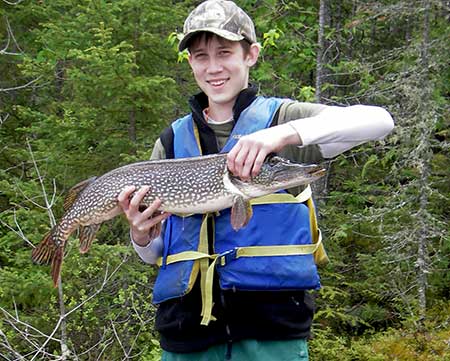
Imagine your “fish’in buddy” landing a trophy fish
In doing research for this Expedition Special, we found there are a lot of differing opinions about what the Boy Scout 50-Miler Program is all about. Most agreed it should be hard ; but that doesn’t mean brutal . In the north country, a 50-miler trip in 5 days requires a pace beyond what many Scouts and Scouters are capable of doing. An hour or two is needed each day to take down camp in the morning. Add another hour or two to set it up at the end of the day. Time is needed for meal preparation and clean-up. Then add in two hours per day for the 10 hour service project. The result is paddlers trying to cover 10-12 miles, with portages, in four to five hours day after day.
This trip is ideal for a Saturday afternoon arrival. Your 7-day High adventure Canoe Trip Expedition Special runs from Sunday to Saturday. Your last evening’s bunkroom is included, with departing for home on Sunday morning.
8 Participants All Inclusive Price: $6000 Bottom Line with tax exemption certificate. If arriving on Tuesday, Wednesday, or Thursday afternoon, deduct $400 per crew of 8.
Canoe Camping
Youth groups, bwca fishing, ncco: your outfitter, about the bwca.

Moscow Tours & Travel Packages 2024/2025
Our 60 most popular moscow trips. compare tour itineraries from 45 tour companies. 308 reviews. 4.7/5 avg rating., popular moscow tours.

St Petersburg & Moscow in Style - Winter
- Explore the majestic St Petersburg & Moscow on private city tours
- Admire the rich Russian history, art and architecture
- Travel to Moscow on a highspeed train
- Enjoy the local cuisine in stylish restaurants

Lower Volga Voyage
- Visit magnificent Red Square and Kremlin and examine the collection at theKremlin’s State Armory.
- Experience Russia’s diverse musical traditions at lively folk music performances
- Explore Volgograd, the site of the decisive battle of World War II’s eastern front

Volga Dream Russian River Cruise

St Petersburg & Moscow in Style - Summer
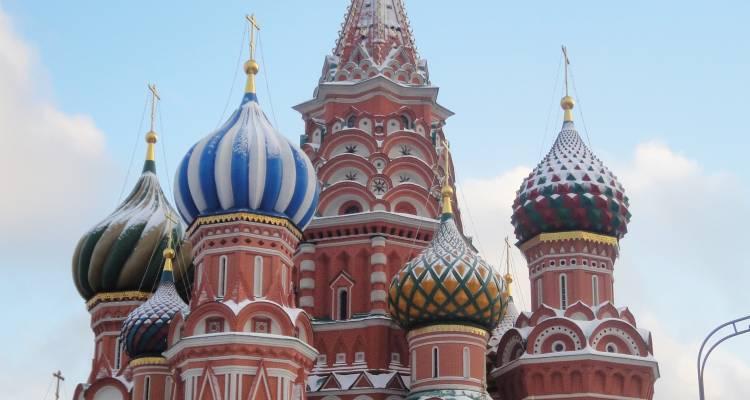
White Russian - 7 days
- Discover Moscow's UNESCO-listed Red Square, home to spectacular St Basil’s Cathedral, Lenin's Mausoleum and the historic GUM Department store
- Explore the grounds of Moscow's mighty Kremlin, with its numerous governmentbuildings, gold-domed cathedrals and the giant tsar bell
- Celebrate New Year's Eve in Moscow!
- Take in the highlights of St Petersburg including a guided tour of the exquisite Church on Spilled Blood, Peter & Paul Fortress and Cathedral
- Take a guided tour of the remarkable Hermitage Museum at the Winter Palace
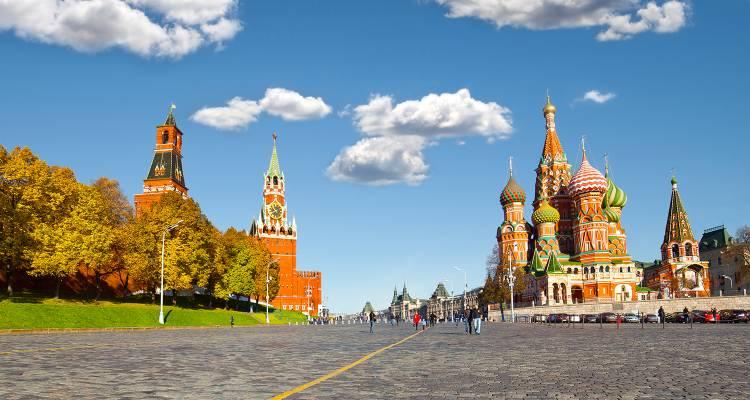
Vodka Shot - 6 days
- Explore the beautiful city of St Petersburg, including the exquisite Church on Spilled Blood, Peter & Paul Fortress and Nevsky Prospekt
- Marvel at the dazzling array of art and exhibits in the world-famous Hermitage Museum, at the Winter Palace in St Petersburg
- Discover a lavish residence of the tsars on a day trip to Catherine Palace at Tsarkoe Selo (winter: mid-October to April) or Peterhof Palace and gardens (summer: May to mid-October)
- Take in the highlights of the capital on a walking tour, visiting Moscow's famous Red Square, home to the historic GUM Department Store, Lenin’s Mausoleum and spectacular St Basil’s Cathedral
- Take a guided tour of the Moscow Kremlin, Russia’s political power house. Stroll around the grounds of this fortified complex, visit the Kremlin's cathedrals and see the mighty Tsar Bell
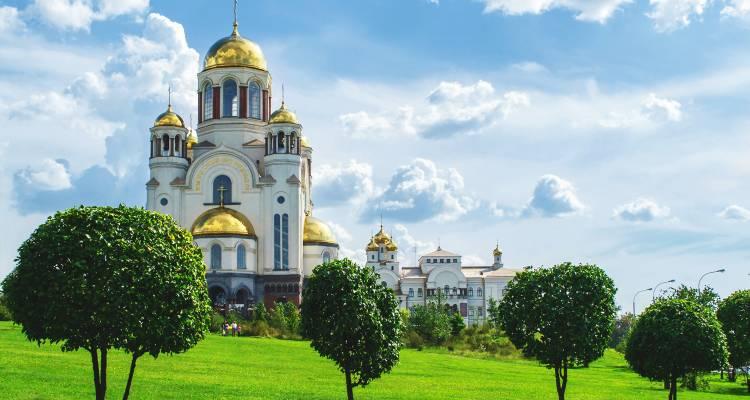
Route of the Romanovs - 10 days
- Learn about the last days of the Romanovs in Yekaterinburg, visiting the sites where Tsar Nicolas II and his family were assassinated and buried
- Straddle two continents at the famous obelisk Europe/Asia border marker in Yekaterinburg
- Experience the Trans-Siberian railway on an overnight train journey from Moscow to Yekaterinburg
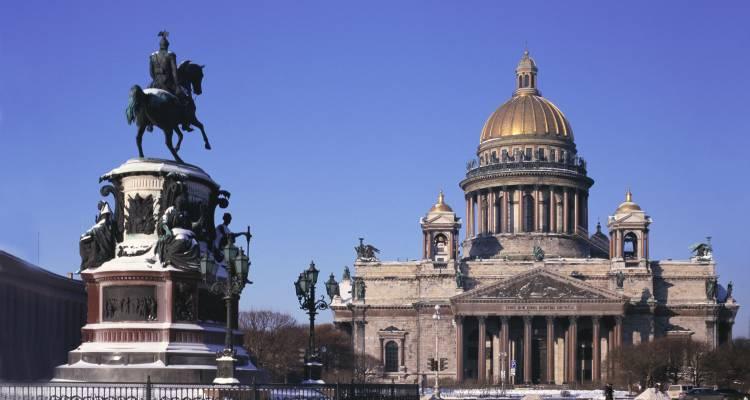
New Year's in Moscow - 9 days
- Visit Catherine Palace at Tsarkoe Selo on Christmas Day and marvel at the incredible Amber Room
- Spend a night in Novgorod, an ancient city by the Volkhov River - explore the kremlin, cathedral and other sights and enjoy a traditional Russian banya (sauna)
All Moscow , expedition cruises, self guided adventures and vacation packages. Find the best guided and expert planned vacation and holiday packages. Read more about Moscow

Small Group Moscow Tours

Back in the USSR - 7 days
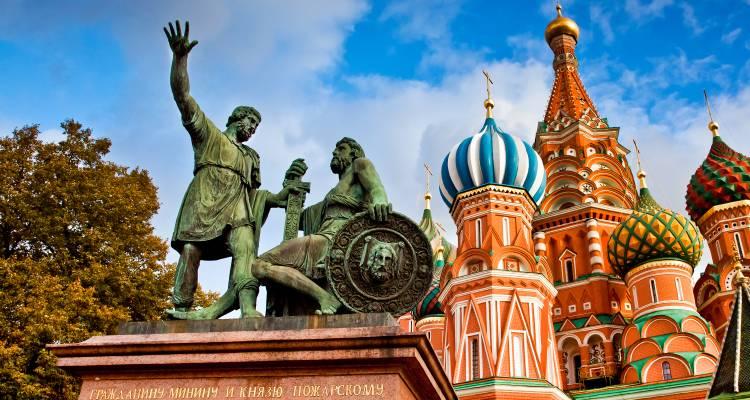
Russian Revolution - 9 days
- Visit historic Novgorod, an ancient city which straddles the Volkhov River. Explore the attractive riverside kremlin and experience a traditional Russian banya (sauna)
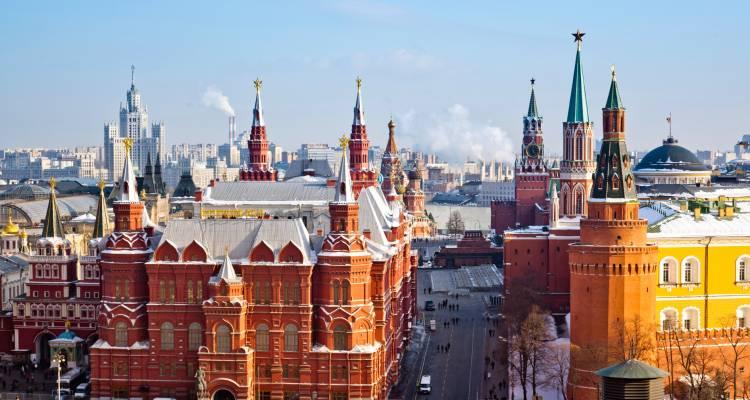
The Snowball - 6 days
- Visit Catherine Palace at Tsarkoe Selo and marvel at the incredible Amber Room
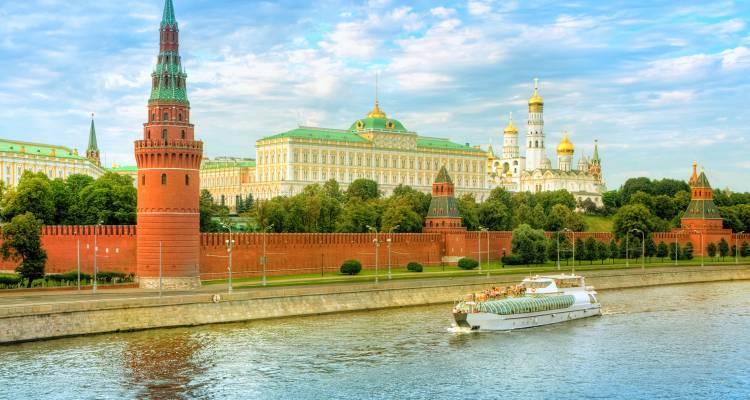
Mood for Moscow - 4 days
- Head underground to visit a Stalinist-era Soviet Bunker on an optional excursion
- Stroll to the vibrant Izmailovo Market, which lies behind the walls of an ancient Kremlin, and shop for an array of souvenirs
Best Moscow Tours by Duration
Tours, Cruises & Private Trips
Best Moscow Tours by Price
Top Moscow Attractions & Experiences
Moscow Tours & Travel Guide
Moscow Attractions & Landmarks Guide
Moscow reviews & ratings, capitals of the north.
some hotels could have been better
It was jam packed with every place I wanted to go and see. I especially love my photo of us setting out on the night time river cruise in St Petersburg and the Peter...
I really did not buy much and what I did buy was small gifts for others .
Johanna-Marie
Good hotels, some better than others. Interesting itinerary
Too rushed. Optional tour rather too short
See all Moscow reviews
Moscow Tours FAQ
1. Does Travelstride have all the tour operators?
2. How does the Member Savings program save me money?
3. Can I trust the tour operator and trip reviews on Travelstride?
4. What does ‘Stride Preferred’ mean?

IMAGES
VIDEO
COMMENTS
Boundary Waters canoe trips. An abundance of route options and easy access for residents across the Midwest makes the Boundary Waters beloved among canoeists. The area's greatest highlight is its unique geography of lakes, some which are interconnected and others which are separated by short overland portages. This is picture-perfect canoe ...
Best Boundary Waters 4-day trips Lac La Croix. Make a run for the border on this 28-mile, out-and-back route starting at entry point 16. Sprawling Lac La Croix is stunning with its fleet of islands, and along the way you'll touch on the more intimate surroundings of Nina Moose Lake and Lake Agnes.
Stone Harbor Wilderness Supply. Based in Grand Marais, Stone Harbor Wilderness Supply offers Boundary Waters canoe day trips starting at $150 per person and a four-day guided kayak camping trip on sprawling Saganaga Lake starting at $725 per person. Photo: Britta Bjur // @brittabjur.
Your go-to BWCA outfitter for canoe trips in Ely, Minnesota since 1984. For over 40 canoe trip seasons we have been one of the leading Boundary Waters outfitters in Ely, Minnesota . We outfit BWCA canoe trips with top-quality gear and meals for both the Boundary Waters Canoe Area Wilderness in northern Minnesota and Quetico Park in Canada.
The Boundary Waters Canoe Area Wilderness (BWCAW, or simply BWCA) is our nation's only large lakeland wilderness, where travel during the ice-free months is primarily via canoe. At over 1 million acres, the area remains the largest wilderness east of the Rockies and north of Florida's Everglades, and the storied Boundary Waters remains the ...
The Boundary Waters Canoe Area Wilderness - BWCA, protected as a true American wilderness, has changed little since the glaciers melted. Canoeing and fishing opportunities are nearly endless on the more than 2,000 lakes and streams found within the forest. With 1,500 miles of canoe routes, nearly 2,200 designated campsites, and more than ...
There are many ways to explore the Boundary Waters, but the two most popular modes of travel are hiking and canoeing. Canoeing. Northeastern Minnesota is created for canoeing. This is the best canoe country in the United States, a place where each year thousands of lives are transformed. Hiking.
Planning a Boundary Waters canoe trip in the Boundary Waters Canoe Area Wilderness (BWCA) involves navigating a labyrinth of over 1,000 lakes and islands. Located on the Minnesota/Canada border, I've made countless trips to the BWCA ever since I was a kid and it always delivers when I want a quiet week filled with great views and adventure.
Then, by applying their professional expertise, make a recommendation based on what the party has in mind. While it may still be "XYZ Lake," it could be Little Indian Sioux River, Mudro Lake, Moose Lake, Island River or Farm Lake. We utilize 24 entry points into the BWCA, and 11 into Quetico Park. They are all different … but, then, so ...
Canoeing in the Boundary Waters is one of Minnesota's most unique outdoor adventures / Peter de Sibour. Accessible primarily by canoe, the Boundary Waters in northern Minnesota is one of America's most beautiful and remote adventures. Plan your first trip using this four-day beginner-friendly itinerary. One of the hardest things about planning ...
Family Super Saver Canoe Trip Package. Each of the Boundary Waters canoe trips packages comes with canoes, all the camping equipment, fine food, maps, and more, right down to the paper toweling and TP. That is why they are called "complete" packages. You bring your personal clothing and hygiene products, a first aid kit, your rod, reel, and ...
See trip details for canoeing the Boundary Waters in Minnesota, one of 100 best American adventure trips from National Geographic. If you're planning to rob a bank in the Midwest, arguably your ...
We're experts at the trip planning process, and we're happy to help! Reach us with our online contact form, at [email protected], or by phone at 218-343-7951. Answers to frequently asked questions, tips and suggestions for planning a successful Boundary Waters (BWCAW) canoe trip from the experts Ely Outfitting Company.
12. Food. Pot Of Wild Edible Plantain. When it comes to camping in the Boundary Waters Canoe Area Wilderness, it is essential to bring the right type of food. Olive oil, canola oil (for fish), honey, and powdered greens are all excellent options for adding healthy fats and nutrients to your meals.
5. Balancing your canoe is more difficult. Balancing, or trimming, a canoe is pretty straightforward in a tandem boat. Put your gear in the middle and ideally put the heavier person in back. Properly balancing a solo canoe takes more finesse. The easiest way to balance a solo canoe is to pack at least two bags.
The Boundary Waters Canoe Area Wilderness (BWCAW) in northern Minnesota is a pristine labyrinth of lakes and rivers spread over a million acres of wilderness. ... Canoeing through the Everglades ...
EPIC MOSCOW Itinerary! (2024) Moscow is the heart of Mother Russia. Just the mention of this city conjures images of colorful bulbous pointed domes, crisp temperatures, and a uniquely original spirit! Moscow has an incredibly turbulent history, a seemingly resilient culture, and a unique enchantment that pulls countless tourists to the city ...
Our High Adventure Boundary Waters trips are 5 to 14 day wilderness canoe camping experiences. Typical treks cover 25 to 100 miles. You will travel through the Boundary Waters Canoe Area in Minnesota or Ontario's Quetico Park. Our High Adventure Expedition Specials may be set-up to include both areas.
Moscow is the biggest city of Russia, with more than 12 million citizens, 400 museums, 11 000 restaurants, and around 500 parks. Our individual tours are here to help you not to get lost in the Russian capital's vibrant rhythm and explore the most exciting spots of Moscow with our professional guides.
DISCOUNT 60%! Buy tickets. Sightseeing river boat trip through the center of Moscow from Zaryadye Park. HIT SALES. Every day. Departure from the Kitay-Gorod / Ustyinsky pier (Kitay-Gorod metro station) Cruise duration 2 hours 20 minetes. We invite you to river cruises on a comfortable boat in the center of Moscow!
Moscow Tours & Travel Packages 2024/2025. Our 60 most popular Moscow trips. Compare tour itineraries from 45 tour companies. 308 reviews. 4.7/5 avg rating. Choose your trip style: